Hummingbirds are among the most fascinating birds on Earth, admired for their dazzling plumage, rapid wingbeats, and extraordinary agility in flight. With more than 300 species spread across the Americas, these tiny creatures play a vital role in pollination and biodiversity. In this identification guide, we’ll explore 32 remarkable types of hummingbirds, their unique features, habitats, behaviors, and how to spot them in the wild. Whether you’re a birdwatcher, nature lover, or wildlife enthusiast, this comprehensive guide will help you recognize and appreciate the diversity of these jewel-like birds — from the well-known Ruby-throated Hummingbird to rare species found deep in tropical rainforests.
Understanding Hummingbirds: An Overview
Hummingbirds (family Trochilidae) are small, nectar-feeding birds native exclusively to the Americas, ranging from Alaska to the southern tip of Chile. Most species inhabit tropical or subtropical regions, especially in Central and South America. Known for their rapid wingbeats — some species flap up to 80 times per second — they can hover, fly backwards, and even upside-down.
Key Identification Features:
Size: Most hummingbirds range from 3 to 5 inches (7.5–13 cm) long.
Bill: Long, slender, and often slightly curved, adapted for nectar feeding.
Plumage: Iridescent feathers that shimmer in the light, with vivid colors on the throat and crown.
Flight: Unique hovering ability and agile maneuvers in mid-air.
Behavior: Highly territorial, especially around feeders and flowering plants.
Now, let’s dive into five of the most iconic species of hummingbirds, each with its own distinct traits and adaptations.
1. Ruby-throated Hummingbird (Archilochus colubris)
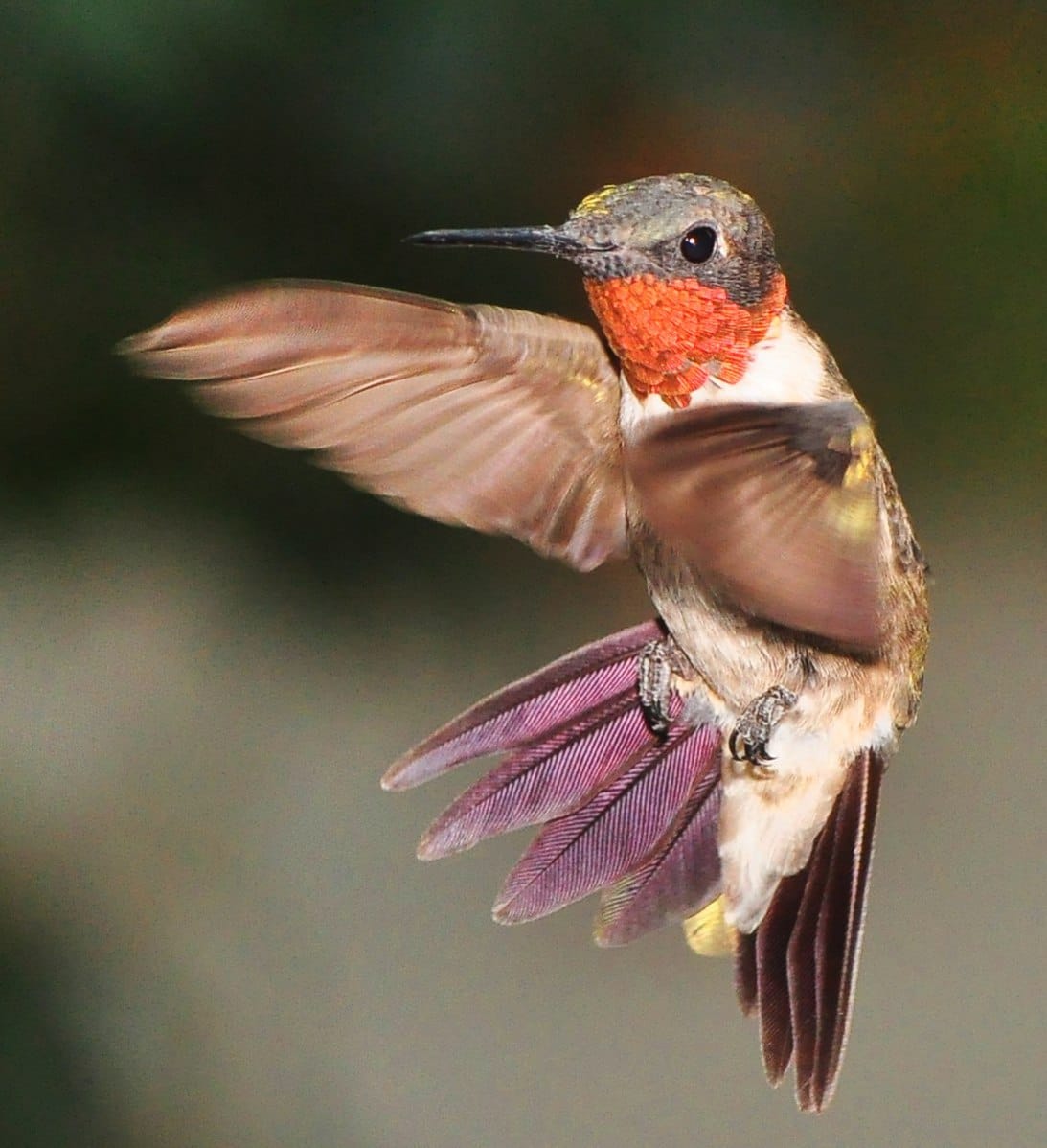
Overview:
The Ruby-throated Hummingbird is perhaps the most recognized hummingbird in North America. It is the only breeding species found east of the Mississippi River, often seen visiting backyard feeders and garden flowers during summer.
Scientific Classification:
Family: Trochilidae
Genus: Archilochus
Species: A. colubris
Size and Appearance:
Length: 3.0–3.5 inches (7.5–9 cm)
Wingspan: 3.1–4.3 inches (8–11 cm)
Weight: 2–6 grams
Males are easily identifiable by their brilliant, ruby-red gorget (throat patch), which appears almost black in low light. Females lack the red throat and instead have a white or pale gray underside with greenish upperparts.
Range and Habitat:
This species breeds throughout eastern North America and migrates to Central America for the winter. It favors deciduous woodlands, gardens, and meadows, often seen hovering near flowering plants and feeders.
Behavior and Feeding:
Ruby-throated Hummingbirds are territorial and highly aggressive in defending feeding spots. Their diet consists mainly of nectar from tubular flowers, but they also consume insects and spiders for protein.
Breeding and Nesting:
Females build tiny, cup-shaped nests using plant down and spider silk, often on tree branches. They lay 1–3 eggs, and incubation lasts about 14–17 days.
Conservation Status:
Listed as Least Concern by the IUCN, though habitat loss and climate change may impact migration routes and breeding grounds.
2. Anna’s Hummingbird (Calypte anna)
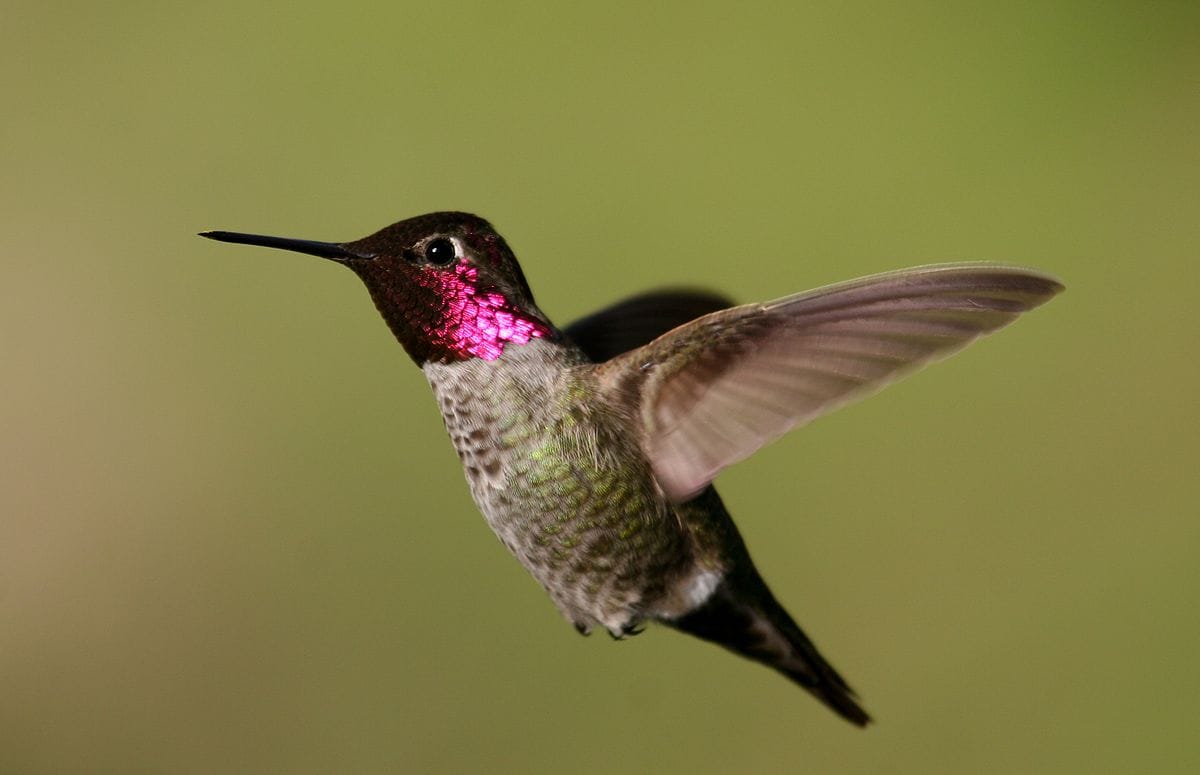
Overview:
Anna’s Hummingbird is one of the most common and adaptable hummingbirds on the Pacific Coast of the United States. Unlike many species, it can be seen year-round in much of its range.
Scientific Classification:
Family: Trochilidae
Genus: Calypte
Species: C. anna
Size and Appearance:
Length: 3.9–4.3 inches (10–11 cm)
Wingspan: 4.7 inches (12 cm)
Weight: 3–6 grams
Males feature a striking iridescent rose-pink throat and crown, which glow brilliantly in sunlight. Females are duller, with green backs and a small patch of pink on the throat.
Range and Habitat:
Native to the western United States and parts of Canada and Mexico, Anna’s Hummingbird thrives in urban gardens, chaparral, coastal scrub, and oak woodlands.
Behavior and Feeding:
These birds are bold and inquisitive, often approaching humans closely. Their diet includes nectar, small insects, and tree sap. Anna’s is also known for its spectacular courtship dive, where males plummet from great heights while producing a sharp chirp.
Breeding and Nesting:
Nesting typically occurs in late winter or early spring. Females build nests on tree branches or shrubs and incubate 2 eggs for about 16 days.
Conservation Status:
Least Concern — populations are stable and even expanding due to their adaptability to urban environments.
3. Rufous Hummingbird (Selasphorus rufus)
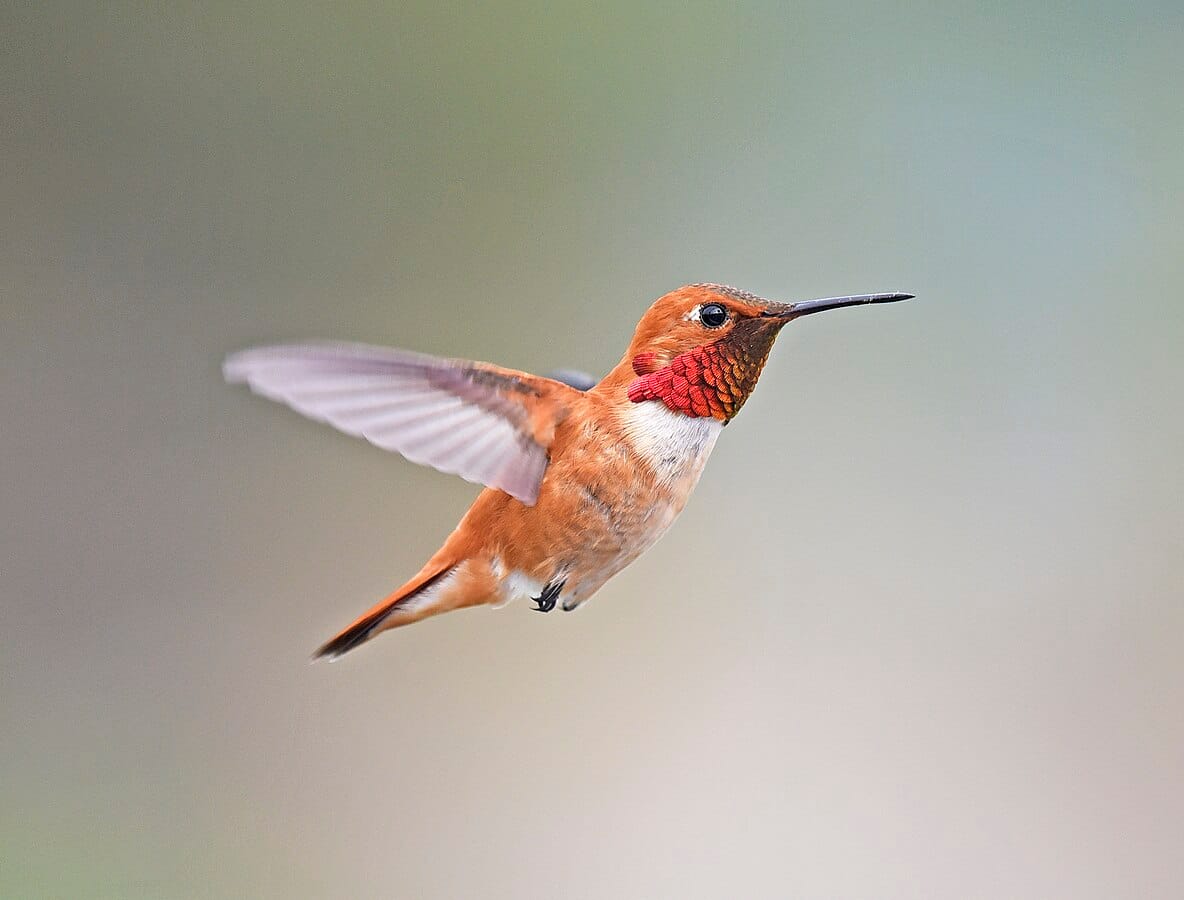
Overview:
Renowned for its fiery plumage and long migrations, the Rufous Hummingbird is one of the most aggressive and determined species. It holds the record for the longest migration relative to body size among birds.
Scientific Classification:
Family: Trochilidae
Genus: Selasphorus
Species: S. rufus
Size and Appearance:
Length: 2.8–3.5 inches (7–9 cm)
Wingspan: 4.3 inches (11 cm)
Weight: 2–5 grams
Males display a brilliant orange-red throat and copper-colored back. Females are greenish-bronze with a rufous wash on the sides and tail.
Range and Habitat:
Rufous Hummingbirds breed in the Pacific Northwest, Alaska, and western Canada and migrate as far south as Mexico. They frequent mountain meadows, forest edges, and gardens.
Behavior and Feeding:
Fiercely territorial, they will chase away much larger birds from feeding areas. Their diet includes nectar, insects, and tree sap. Their migration route forms a loop, traveling north along the Pacific Coast in spring and south through the Rocky Mountains in fall.
Breeding and Nesting:
Females construct nests from plant fibers and spider silk, laying 2 eggs per clutch. Incubation lasts about 15–17 days.
Conservation Status:
Near Threatened — populations are declining slightly due to habitat loss and changes in flower availability caused by climate shifts.
4. Allen’s Hummingbird (Selasphorus sasin)
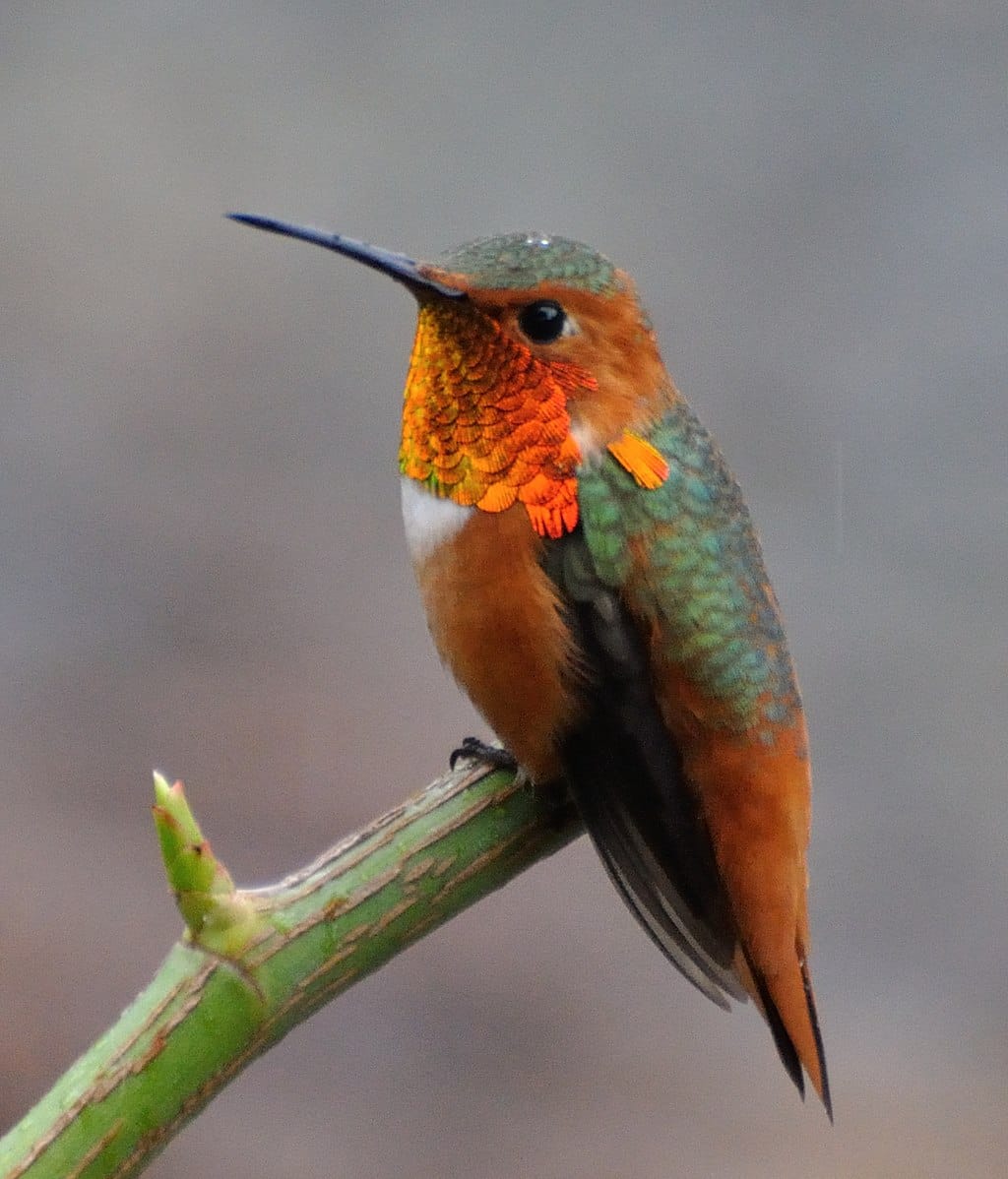
Overview:
Allen’s Hummingbird is a close relative of the Rufous, known for its similar coloration but more limited range. It is a coastal species, often found in California’s coastal scrub and gardens.
Scientific Classification:
Family: Trochilidae
Genus: Selasphorus
Species: S. sasin
Size and Appearance:
Length: 3.0–3.5 inches (7.5–9 cm)
Wingspan: 4.3 inches (11 cm)
Weight: 2–4 grams
Males feature a vibrant orange body with a shimmering red throat, while females are green with rufous sides and tail.
Range and Habitat:
Breeding occurs along the Pacific coast from southern Oregon to southern California. Some populations migrate to central Mexico for winter, while others remain year-round in coastal areas.
Behavior and Feeding:
Allen’s Hummingbirds are agile and aggressive defenders of nectar sources. Their diet includes nectar, insects, and spiders. They are particularly drawn to native coastal plants like monkey flowers and manzanitas.
Breeding and Nesting:
Females build small, camouflaged nests in shrubs or trees, laying 2 eggs per clutch. Incubation lasts 15–17 days, and fledglings leave the nest about 20 days after hatching.
Conservation Status:
Near Threatened — urbanization and habitat fragmentation pose ongoing threats.
5. Calliope Hummingbird (Selasphorus calliope)
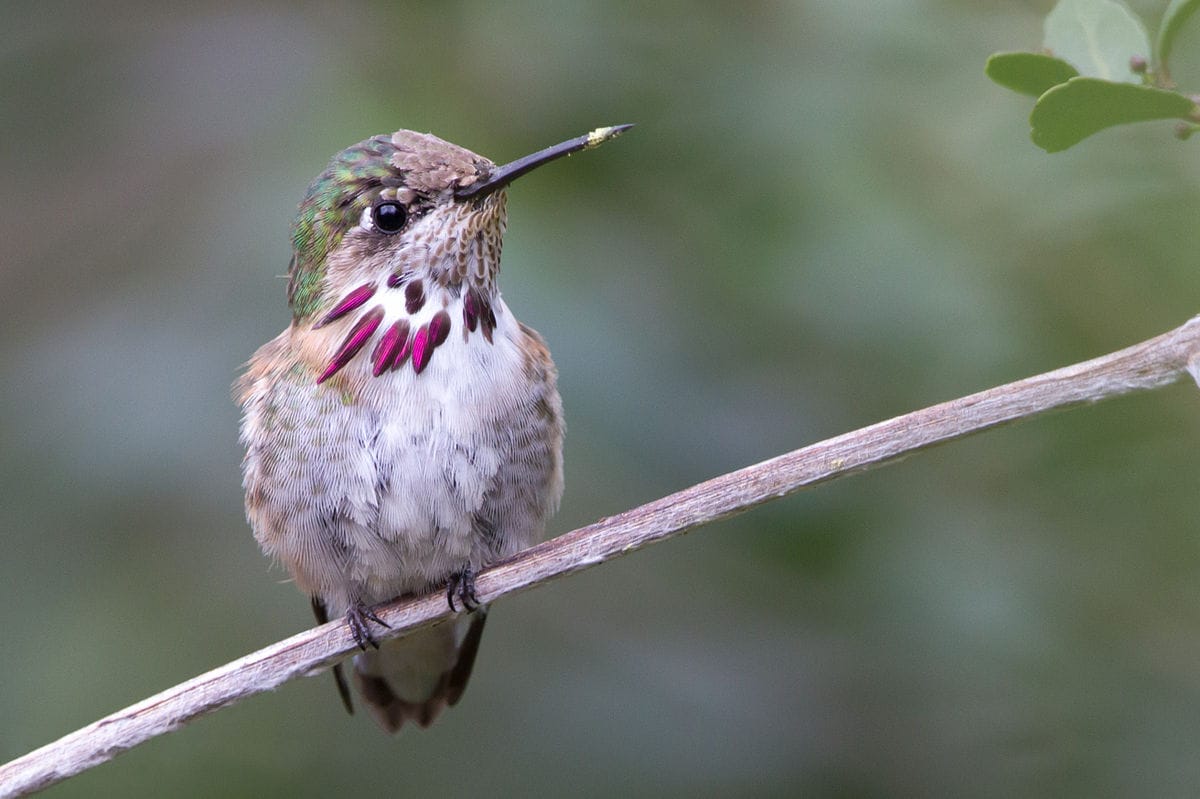
Overview:
The Calliope Hummingbird is the smallest bird in North America and one of the smallest in the world. Despite its size, it undertakes an impressive migratory journey.
Scientific Classification:
Family: Trochilidae
Genus: Selasphorus
Species: S. calliope
Size and Appearance:
Length: 2.8–3.3 inches (7–8.4 cm)
Wingspan: 4.1–4.3 inches (10.5–11 cm)
Weight: 2–3 grams
Males are notable for their striking magenta streaks on the throat, which fan out into a starburst pattern. Females are greenish with a pale underside and peach-colored flanks.
Range and Habitat:
This species breeds in the mountainous regions of the western United States and migrates to Mexico and Central America for the winter. It prefers alpine meadows, open woodlands, and riparian zones.
Behavior and Feeding:
Despite its small size, the Calliope is highly territorial and will chase larger hummingbirds from feeders. It feeds primarily on nectar but supplements its diet with insects.
Breeding and Nesting:
Females build tiny, delicate nests on conifer branches, often reusing nesting materials from previous seasons. Incubation lasts about 15 days.
Conservation Status:
Least Concern — populations remain stable, though climate change could affect breeding habitats.
6. Violet-crowned Hummingbird (Leucolia violiceps)
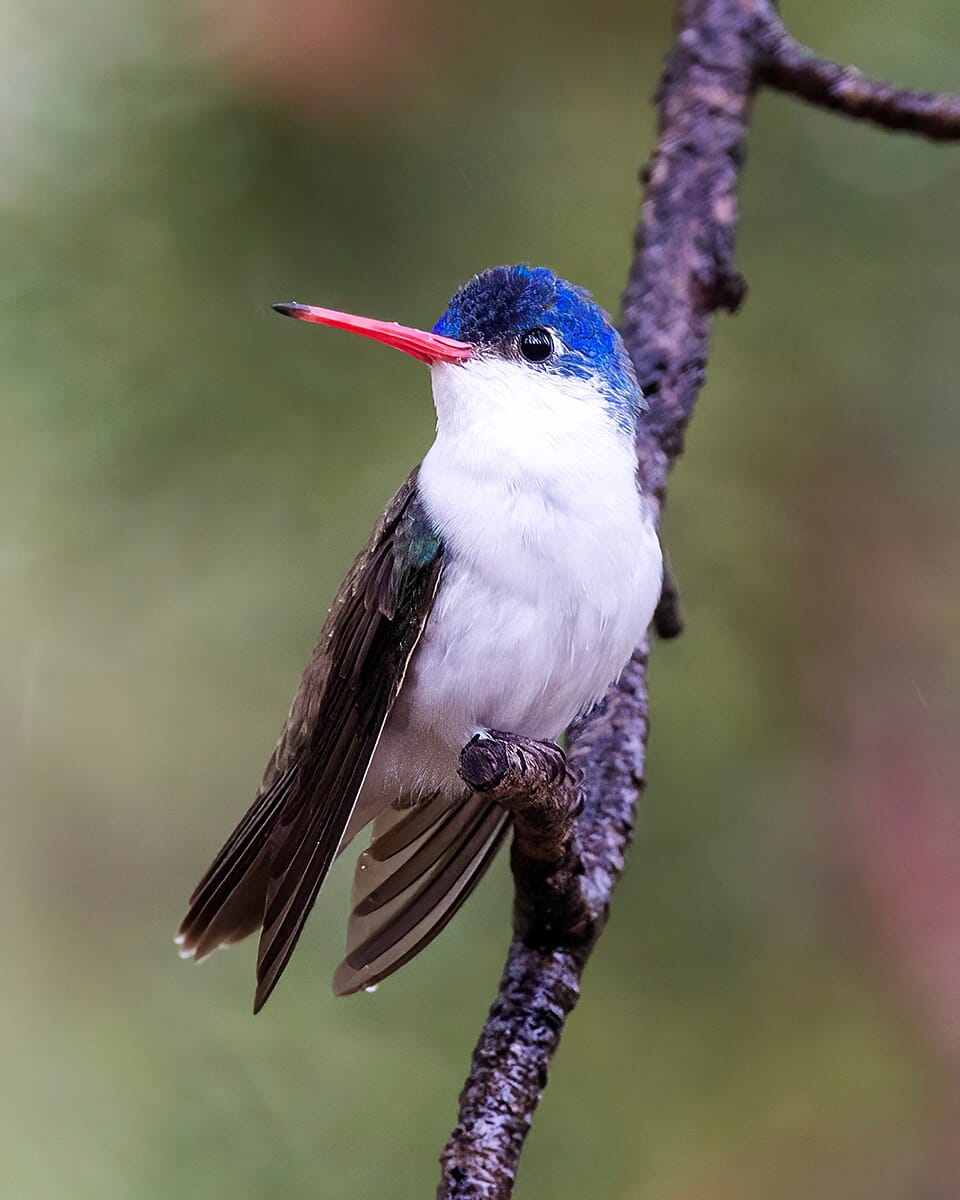
Overview:
The Violet-crowned Hummingbird is a striking and elegant species known for its dazzling violet-blue crown and clean white underparts. Less common than some of its North American relatives, this hummingbird is highly prized by birdwatchers for its distinctive appearance and relatively calm temperament. Unlike many hummingbirds that are intensely territorial, the Violet-crowned tends to be more tolerant of others, often sharing feeding spots with different species.
Scientific Classification:
Family: Trochilidae
Genus: Leucolia
Species: L. violiceps
Size and Appearance:
Length: 4.0–4.3 inches (10–11 cm)
Wingspan: 4.7 inches (12 cm)
Weight: 4–5 grams
This medium-sized hummingbird features a vivid violet crown and a metallic green back that contrasts beautifully with its white throat, chest, and belly. Its bill is long, straight, and bicolored — bright red with a black tip — which makes it easy to distinguish from similar species.
Range and Habitat:
The Violet-crowned Hummingbird is primarily found in arid and semi-arid regions of the southwestern United States (southern Arizona and New Mexico) and extends into Mexico and Central America. It thrives in riparian woodlands, desert scrublands, and canyons, often near streams or water sources.
Behavior and Feeding:
Although capable of defending a food source, this species is generally less aggressive than other hummingbirds. It feeds primarily on nectar from native flowering plants such as agaves, ocotillos, and desert willows. It also supplements its diet with small insects and spiders, which provide vital proteins.
Breeding and Nesting:
Breeding typically occurs from May to July. Females build small, cup-shaped nests made of plant fibers, moss, and spider silk, often placed on horizontal branches near water. They lay two white eggs, and incubation lasts about 15–18 days.
Conservation Status:
Least Concern — populations are stable, but water management and habitat loss in riparian areas could pose future threats.
7. Black-chinned Hummingbird (Archilochus alexandri)
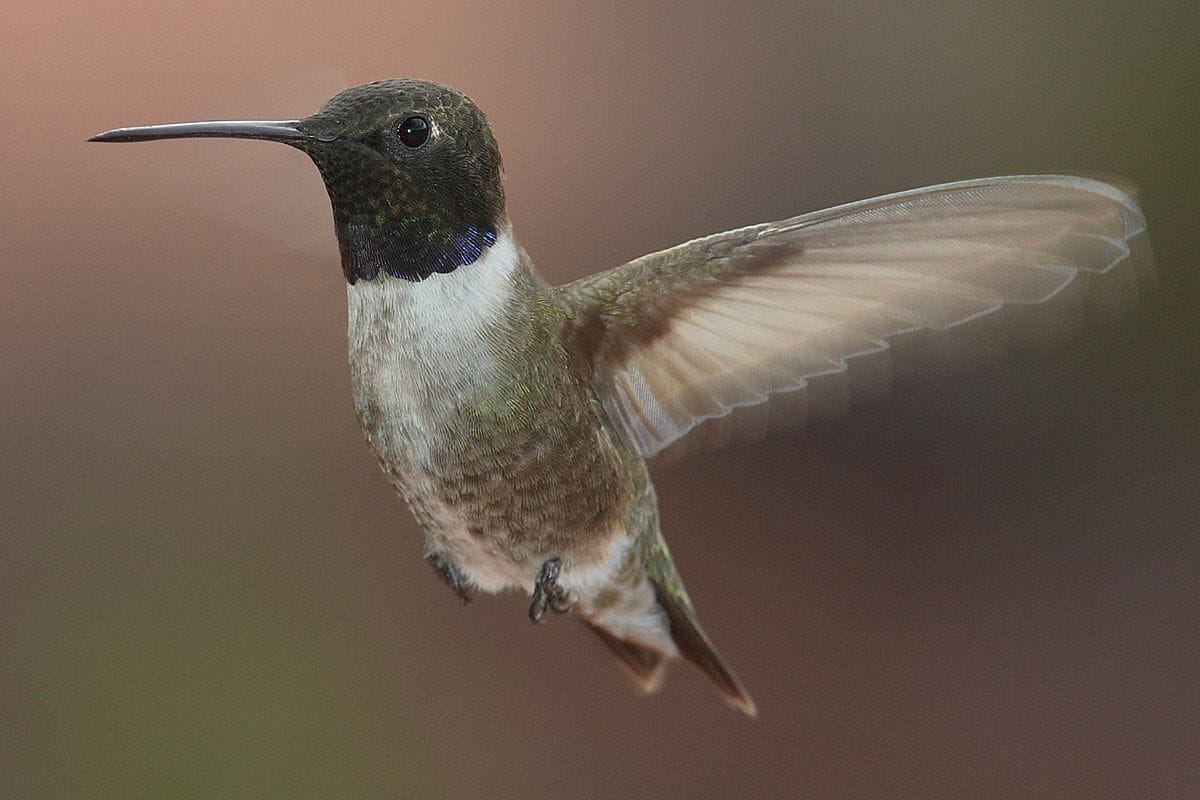
Overview:
The Black-chinned Hummingbird is one of the most widespread species in the western United States and a common visitor to backyard feeders. Known for its subtle beauty and adaptable nature, this species is often overlooked due to its understated plumage, yet it’s a vital pollinator and a fascinating bird to observe.
Scientific Classification:
Family: Trochilidae
Genus: Archilochus
Species: A. alexandri
Size and Appearance:
Length: 3.25–3.5 inches (8.3–9 cm)
Wingspan: 4.3 inches (11 cm)
Weight: 2.4–4.5 grams
Males have a black throat with a narrow, iridescent purple band at the base that is visible only in certain lighting. Females are paler with a white chest and greenish back. Both sexes have a slender, slightly downcurved bill.
Range and Habitat:
The Black-chinned Hummingbird breeds across much of the western and southwestern United States and migrates to Mexico and Central America for the winter. It occupies a variety of habitats, including riparian woodlands, scrublands, meadows, and suburban gardens.
Behavior and Feeding:
Highly adaptable, this hummingbird often visits feeders and shows a remarkable tolerance for human presence. It feeds primarily on nectar from tubular flowers and is known to hover with exceptional precision. It also captures insects mid-air — a behavior known as “hawking” — and gleans small arthropods from foliage.
Breeding and Nesting:
Females construct small nests on tree branches or shrubs, usually near water sources. The nests are made from plant fibers, down, and spider silk. Incubation lasts about 14–16 days, and chicks fledge after approximately 20 days.
Conservation Status:
Least Concern — populations are stable, though climate change and habitat alterations could affect migration timing and food availability.
8. Lucifer Hummingbird (Calothorax lucifer)
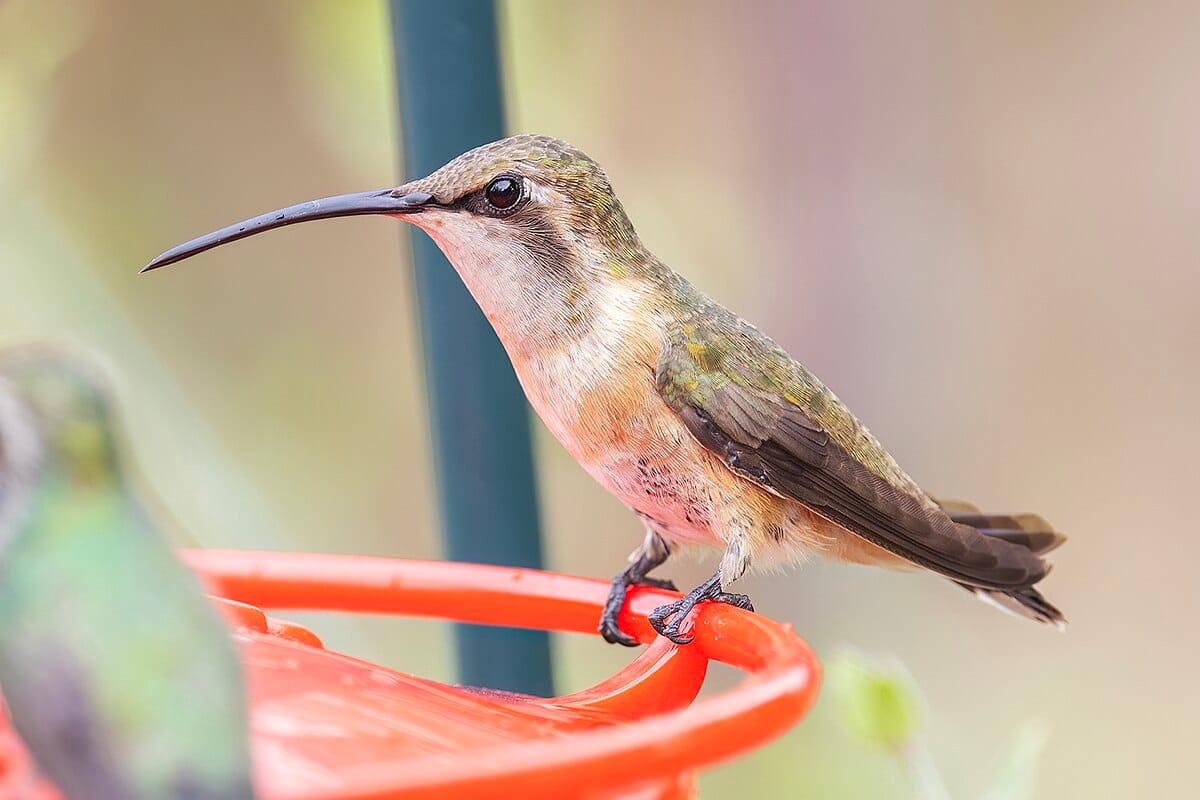
Overview:
With its dramatic name and equally dramatic appearance, the Lucifer Hummingbird is a rare and captivating species native to the arid canyons and deserts of the southwestern United States and northern Mexico. Its distinctive gorget and elegant, curved bill make it a sought-after sighting among birders.
Scientific Classification:
Family: Trochilidae
Genus: Calothorax
Species: C. lucifer
Size and Appearance:
Length: 3.5–4.3 inches (9–11 cm)
Wingspan: 4.3–4.7 inches (11–12 cm)
Weight: 2.7–3.5 grams
Males boast a brilliant magenta-purple gorget that flares out into a forked shape, contrasting with their greenish-bronze upperparts and white chest. Females are more muted in color, with a pale throat and buffy underparts.
Range and Habitat:
Lucifer Hummingbirds are found mainly in northern Mexico, with smaller breeding populations in southern Arizona, New Mexico, and west Texas. They inhabit desert canyons, rocky slopes, and scrublands — often at elevations between 3,000 and 6,000 feet (900–1,800 m).
Behavior and Feeding:
Adapted to arid environments, they often feed on nectar from desert plants such as agave, ocotillo, and chuparosa. Their long, slightly decurved bill is specialized for accessing deep tubular flowers. They also consume small insects and spiders for protein.
Breeding and Nesting:
Females build tiny nests on desert shrubs or yucca plants, often well-hidden to avoid predators. The nests are composed of plant fibers and spider silk. Incubation takes about 15–17 days, and fledging occurs roughly 20 days after hatching.
Conservation Status:
Least Concern — populations are stable, though they are considered locally uncommon due to their specialized habitat requirements.
9. Berylline Hummingbird (Saucerottia beryllina)
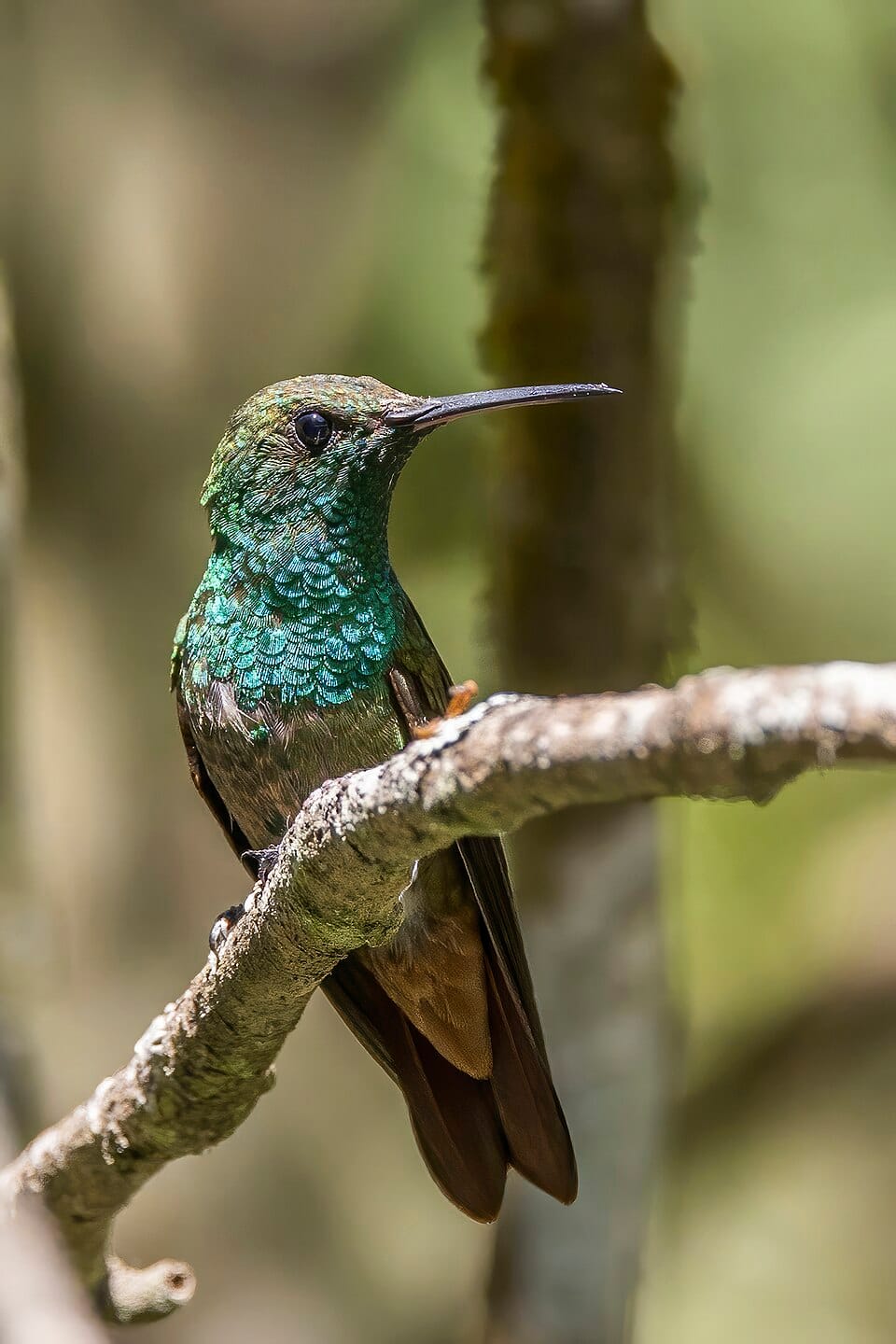
Overview:
The Berylline Hummingbird is named for its luminous green plumage, which shimmers like the gemstone beryl. A medium-sized species found mostly in Mexico and Central America, it occasionally strays into the southwestern United States, delighting birders with its rare appearances.
Scientific Classification:
Family: Trochilidae
Genus: Saucerottia
Species: S. beryllina
Size and Appearance:
Length: 4.3–4.7 inches (11–12 cm)
Wingspan: 4.7–5.1 inches (12–13 cm)
Weight: 4–5 grams
This hummingbird is characterized by its bright emerald-green head, back, and chest, complemented by a chestnut-red tail and wings. The bill is mostly black with a slight reddish base.
Range and Habitat:
The Berylline Hummingbird inhabits montane forests, pine-oak woodlands, and tropical highlands of Mexico, Honduras, and Nicaragua. Occasional vagrants are seen as far north as Arizona and New Mexico.
Behavior and Feeding:
Berylline Hummingbirds are territorial and aggressive, often chasing away larger birds. They primarily feed on nectar from flowering trees and shrubs, but they also catch insects on the wing and glean them from foliage.
Breeding and Nesting:
Breeding occurs from March to July. Females construct nests from plant down, moss, and spider silk, often attached to tree branches overhanging streams. The incubation period is about 15–16 days.
Conservation Status:
Least Concern — the species is common in its range, though deforestation poses a potential risk.
10. Buff-bellied Hummingbird (Amazilia yucatanensis)
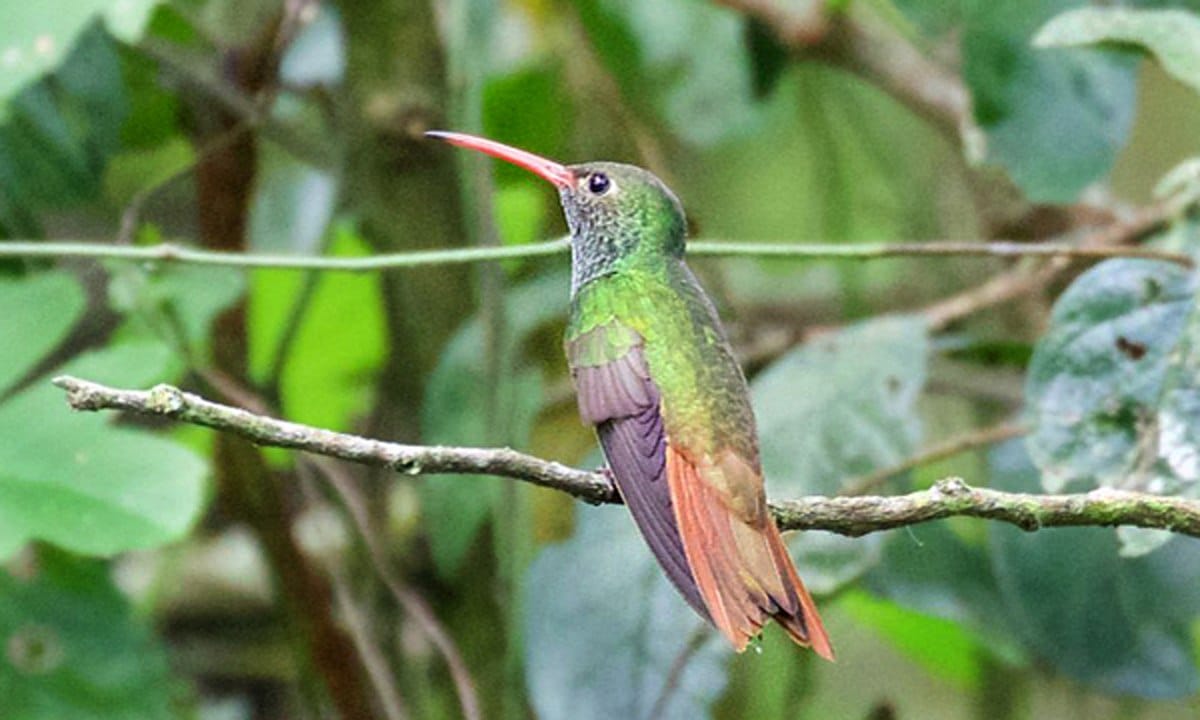
Overview:
The Buff-bellied Hummingbird is a vibrant and energetic species native to the Gulf Coast region. Known for its rich, colorful plumage and slightly larger size, it’s a frequent visitor to gardens and feeders in southern Texas and Mexico.
Scientific Classification:
Family: Trochilidae
Genus: Amazilia
Species: A. yucatanensis
Size and Appearance:
Length: 3.9–4.3 inches (10–11 cm)
Wingspan: 4.7 inches (12 cm)
Weight: 4–5 grams
This species is easily recognized by its metallic green back, rufous tail, and warm buff-colored underparts. The bill is reddish-orange with a dark tip, and its wings are broad and rounded.
Range and Habitat:
Buff-bellied Hummingbirds are found along the Gulf Coast of the United States (especially Texas) and throughout eastern Mexico and the Yucatán Peninsula. They prefer subtropical woodlands, thickets, gardens, and coastal scrub.
Behavior and Feeding:
They are active and territorial, often dominating feeders and flowering shrubs. Their diet consists of nectar from a variety of native and ornamental plants, as well as insects caught mid-air or plucked from foliage.
Breeding and Nesting:
Females typically build nests in low shrubs or trees, often reusing nest materials from previous seasons. The clutch size is usually two eggs, and incubation lasts about 15–17 days.
Conservation Status:
Least Concern — populations are stable, and the species is well-adapted to human-modified landscapes.
11. Broad-billed Hummingbird (Cynanthus latirostris)
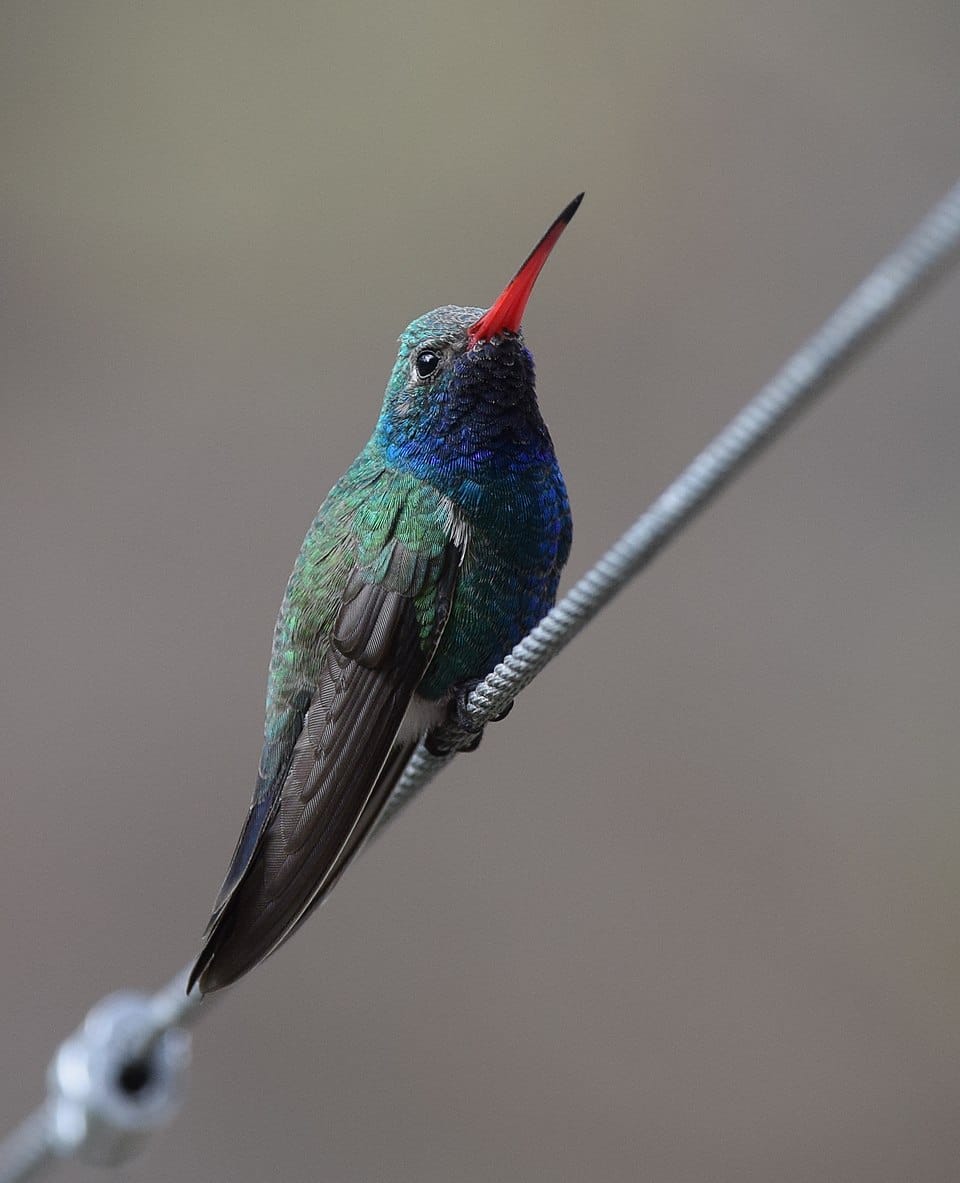
Scientific Name
Cynanthus latirostris
Size
Length: 3.1 – 3.9 inches (8 – 10 cm)
Weight: 3 – 4 grams
Wingspan: ~4.7 inches (12 cm)
Range
The Broad-billed Hummingbird is native to the southwestern United States and Mexico. It breeds primarily in Arizona and New Mexico and migrates south into central and southern Mexico during colder months.
Habitat
Preferring riparian woodlands, canyon edges, desert scrublands, and mountainous regions, this hummingbird thrives in habitats with abundant flowering plants and running water. They are commonly found near streams, gardens, and arid foothills with blooming vegetation.
Diet
The diet consists mainly of nectar from tubular flowers, particularly those of desert plants such as agave and ocotillo. It also supplements its diet with small insects and spiders, which provide essential proteins for energy and growth.
Nesting
Females build small cup-shaped nests on thin branches or low shrubs, often near water sources. The nests are constructed with plant fibers, spider silk, and lichen for camouflage. Typically, they lay 2 tiny white eggs and incubate them for about 15–18 days.
Behavior
Broad-billed Hummingbirds are known for their agile flight, often darting between flowers and performing territorial aerial chases to defend feeding sites. Males are especially territorial and will aggressively chase intruders away from nectar sources.
Conservation
The species is listed as Least Concern by the IUCN. However, habitat loss and climate change may impact their breeding range. Garden planting with native flowers and maintaining riparian habitats support their populations.
Identification Tips
The male is unmistakable with its shimmering emerald-green body, cobalt-blue throat, and bright orange-red bill tipped in black. Females are duller, with a green back, pale gray underparts, and a slightly curved orange bill.
Fun Facts
Males perform elaborate courtship dives to impress females.
This species is one of the earliest hummingbirds to arrive in the U.S. during spring migration.
12. Costa’s Hummingbird (Calypte costae)
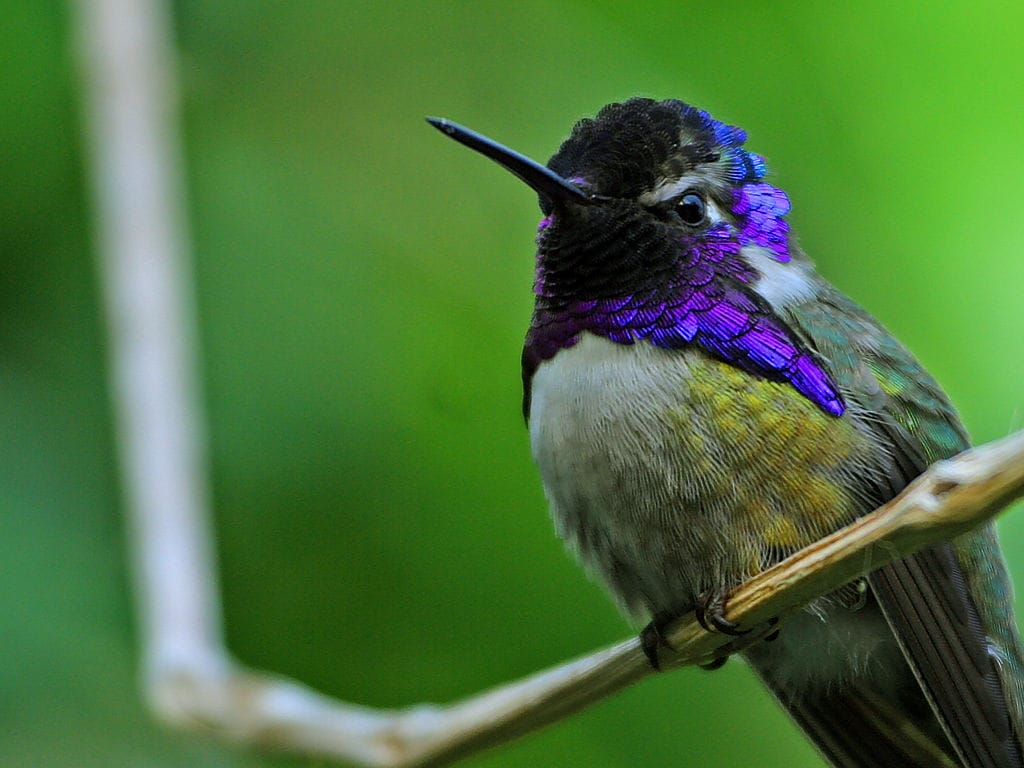
Scientific Name
Calypte costae
Size
Length: 3 – 3.5 inches (7.5 – 9 cm)
Weight: 2 – 3 grams
Wingspan: ~4 inches (10 cm)
Range
Costa’s Hummingbird is found throughout the deserts of the southwestern United States, including California, Nevada, and Arizona, and extends into Baja California and northwestern Mexico.
Habitat
They thrive in arid and semi-arid environments such as desert scrub, chaparral, and coastal sagebrush. During migration, they also visit suburban gardens and parks with nectar-rich flowers.
Diet
Their diet primarily consists of nectar from desert plants like chuparosa, penstemon, and desert lavender. They also catch tiny insects mid-flight to provide necessary proteins.
Nesting
Females build nests in shrubs or cacti, often shaded to protect eggs from intense desert heat. The nests are crafted with plant down, spider silk, and lichen. Each clutch usually consists of two eggs, incubated for about 15 days.
Behavior
Costa’s Hummingbirds are solitary and territorial, with males often chasing rivals from their feeding and breeding territories. They perform spectacular “J-shaped” courtship dives accompanied by high-pitched chirps.
Conservation
Currently classified as Least Concern, their populations are stable. However, urbanization and habitat fragmentation remain potential threats.
Identification Tips
Males are striking with their iridescent purple crown and elongated gorget feathers that flare like a collar. Females are more subdued, with green upperparts and white underparts lightly speckled with gray.
Fun Facts
Costa’s Hummingbird has one of the smallest ranges of any North American hummingbird.
They can enter torpor — a hibernation-like state — to conserve energy during cold desert nights.
13. Blue-throated Mountain-gem (Lampornis clemenciae)
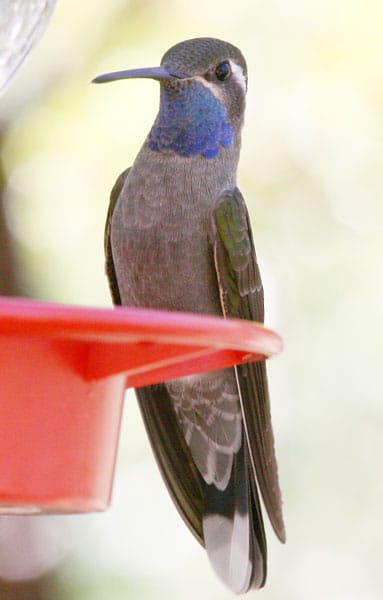
Scientific Name
Lampornis clemenciae
Size
Length: 4.3 – 5.1 inches (11 – 13 cm)
Weight: 7 – 8 grams
Wingspan: ~6 inches (15 cm)
Range
Native to the highlands of Mexico and Central America, the Blue-throated Mountain-gem occasionally migrates into the mountains of southeastern Arizona, New Mexico, and west Texas.
Habitat
Preferring pine-oak forests, mountain canyons, and shaded ravines, these hummingbirds inhabit higher elevations (1,200–3,000 m) where cool, moist conditions prevail.
Diet
Nectar from forest flowers such as columbine, trumpet vine, and salvia forms the bulk of their diet. They also hunt small insects, especially during the breeding season, for added nutrition.
Nesting
Females build larger-than-average nests, often on horizontal tree branches, decorated with moss and lichen for camouflage. Clutches usually contain two eggs, which hatch after 17–19 days of incubation.
Behavior
Known for their calm but territorial nature, Blue-throated Mountain-gems often dominate feeding stations, chasing away smaller hummingbirds. They are strong fliers capable of long-distance migration.
Conservation
Their population is stable and classified as Least Concern, though deforestation in their montane habitat poses a potential long-term threat.
Identification Tips
The male is easily recognized by its deep metallic blue throat patch, white eye-line, and dark green plumage. Females lack the blue throat but have similar greenish upperparts and pale gray bellies.
Fun Facts
This is the largest hummingbird species regularly seen in the United States.
Males are known for a distinctive rapid “chip-chip-chip” call that echoes through mountain forests.
14. White-eared Hummingbird (Basilinna leucotis)
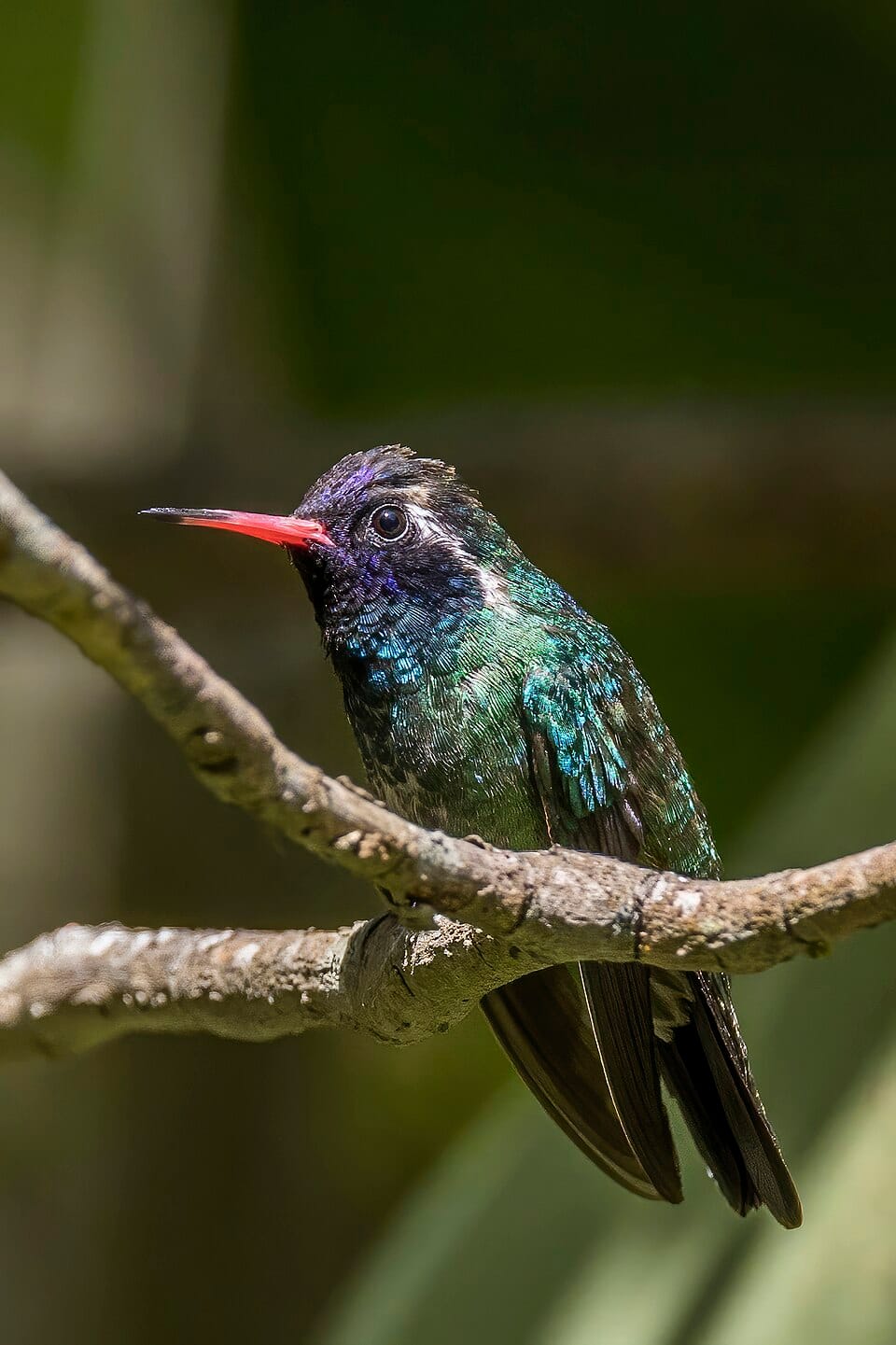
Scientific Name
Basilinna leucotis
Size
Length: 3.5 – 4 inches (9 – 10 cm)
Weight: 3 – 4 grams
Wingspan: ~4.7 inches (12 cm)
Range
The White-eared Hummingbird’s range extends from the highlands of Mexico through Central America and occasionally into southern Arizona and New Mexico.
Habitat
They prefer forest edges, pine-oak woodlands, montane meadows, and flowering clearings at elevations of 1,500–3,000 m. They are also frequent visitors to hummingbird feeders in mountain towns.
Diet
Nectar from a variety of forest blossoms, such as salvias and trumpet flowers, forms the majority of their diet. They also feed on small insects and spiders caught mid-air or gleaned from foliage.
Nesting
Nests are built low in shrubs or small trees and are well-camouflaged with moss and lichen. Females lay two eggs per clutch and incubate them for about 15–17 days.
Behavior
White-eared Hummingbirds are energetic and territorial, often chasing away other birds from their preferred flowers. Despite their size, they are highly competitive and fearless.
Conservation
Listed as Least Concern, their populations are stable. However, logging and habitat degradation in montane forests pose localized threats.
Identification Tips
Males feature a vivid emerald-green body, a striking white ear stripe, and a reddish bill with a black tip. Females resemble males but are slightly duller and lack the intense throat coloration.
Fun Facts
One of the few hummingbird species regularly seen at elevations above 2,500 m.
They are known to hybridize with related species in overlapping territories.
15. Rivoli’s Hummingbird (formerly Magnificent Hummingbird) (Eugenes fulgens)
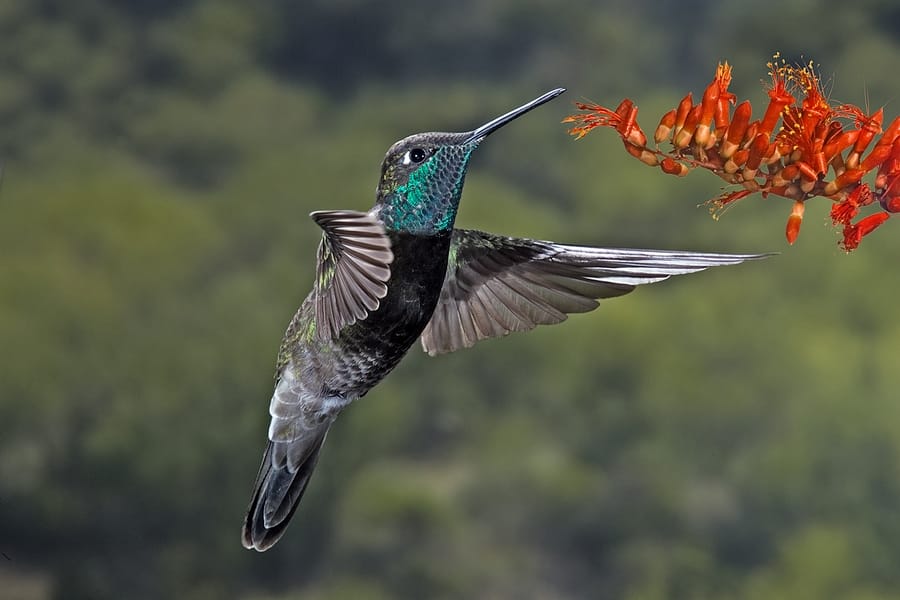
Scientific Name
Eugenes fulgens
Size
Length: 4.3 – 5.5 inches (11 – 14 cm)
Weight: 7 – 8 grams
Wingspan: ~7 inches (18 cm)
Range
Rivoli’s Hummingbird inhabits mountainous regions from the southwestern United States (Arizona, New Mexico) through Mexico and Central America to Nicaragua. It is a resident species in many parts of its range, though some populations migrate seasonally.
Habitat
Preferring pine-oak forests, mountain canyons, and cloud forests, they are often found at elevations of 1,800 – 3,200 meters. They frequent forest edges and flowering clearings and occasionally visit high-altitude gardens.
Diet
Their diet includes nectar from a variety of mountain flowers, such as columbine, sage, and trumpet creeper. They also hunt small flying insects and spiders, particularly during breeding.
Nesting
Females build nests high on tree branches, often near streams. The nests are larger than most hummingbirds’, made from moss, plant fibers, and spider silk. Incubation lasts about 15–18 days, and chicks fledge after 20–25 days.
Behavior
Rivoli’s Hummingbirds are strong and powerful fliers capable of covering long distances. Males are dominant at feeders and aggressively defend feeding territories. Their deep, rapid wingbeats produce a low humming sound distinct from other species.
Conservation
Currently classified as Least Concern, their populations are stable. However, deforestation in montane forests can threaten local populations.
Identification Tips
Males are spectacular, with a dark green body, a brilliant emerald-green throat, and a violet crown. Females are duller, with green backs and grayish-white underparts. Their larger size and longer bill distinguish them from similar species.
Fun Facts
Rivoli’s Hummingbird is among the largest hummingbirds found north of Mexico.
They can enter a torpor-like state to conserve energy during cold nights at high altitudes.
16. Broad-tailed Hummingbird (Selasphorus platycercus)
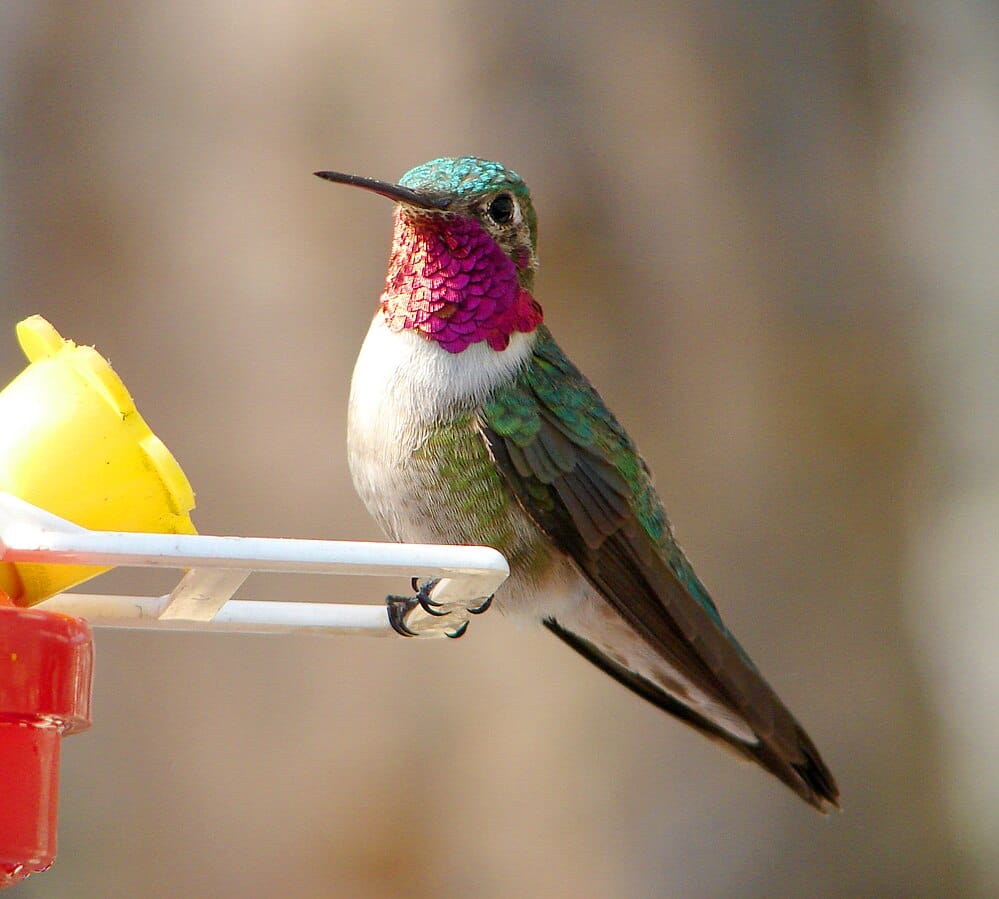
Scientific Name
Selasphorus platycercus
Size
Length: 3.5 – 4.3 inches (9 – 11 cm)
Weight: 2.8 – 4 grams
Wingspan: ~5.1 inches (13 cm)
Range
Broad-tailed Hummingbirds breed in the western United States and southern Canada, especially in mountainous areas from Arizona and Colorado to Wyoming. They migrate to Mexico and Central America for the winter.
Habitat
They prefer montane meadows, forest edges, and alpine environments at elevations between 1,800 and 3,400 meters. During migration, they frequent gardens and open woodlands.
Diet
Nectar is their primary food source, with favorites including larkspur, columbine, and Indian paintbrush. They also eat small insects and spiders to supplement their diet.
Nesting
Females build nests on horizontal tree branches, often concealed among foliage. The nests are lined with plant fibers and spider silk for elasticity. They lay two eggs, which hatch after about 15 days.
Behavior
Males perform a signature “trilling dive” during courtship — a sound created by air rushing through their wingtips. Broad-tailed Hummingbirds are territorial but less aggressive than Rufous or Black-chinned hummingbirds.
Conservation
Populations are stable and listed as Least Concern. However, climate change affecting alpine flower bloom times poses a potential future threat.
Identification Tips
Males have a striking rose-red gorget, green upperparts, and a white chest. Females and juveniles are green above with pale underparts and rufous flanks.
Fun Facts
Their heart beats over 1,200 times per minute during flight.
They can hover motionless even in windy mountain conditions, an adaptation to high-altitude living.
17. Green Violet-ear Hummingbird (Colibri thalassinus)
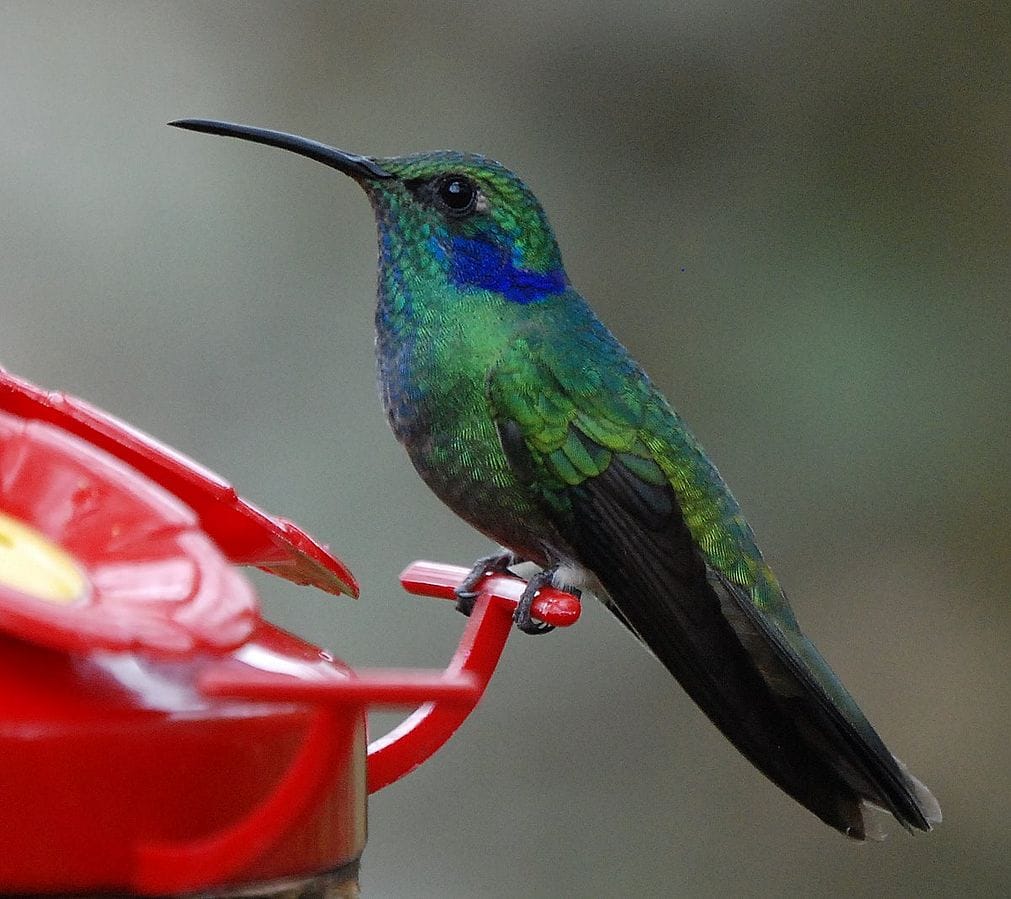
Scientific Name
Colibri thalassinus
Size
Length: 4.3 – 4.7 inches (11 – 12 cm)
Weight: 5 – 6 grams
Wingspan: ~5.5 inches (14 cm)
Range
The Green Violet-ear is widely distributed across montane regions from Mexico and Central America to the Andes of South America. Occasionally, it wanders north into Texas or even the eastern United States during migration.
Habitat
It prefers montane cloud forests, pine-oak woodlands, and forest edges at elevations of 1,200 – 2,800 meters. During seasonal movements, it can also be found in gardens, coffee plantations, and forest clearings.
Diet
Their primary diet is nectar from high-elevation flowers such as salvias, fuchsias, and columbines. They also catch small insects and spiders, especially during breeding.
Nesting
Females build nests on horizontal branches or tree forks, camouflaged with moss and lichens. The clutch usually contains two white eggs, incubated for about 15–18 days.
Behavior
Green Violet-ears are highly aggressive and often dominate feeders, chasing away smaller species. They are also nomadic, following seasonal flower blooms. Males are known for their spectacular territorial displays and loud vocalizations.
Conservation
Listed as Least Concern, their populations remain stable. Deforestation in highland areas could pose future threats, but their adaptability to secondary forests and gardens helps sustain their numbers.
Identification Tips
Both sexes are metallic green overall with a shimmering violet ear patch (auricular stripe) and a slightly forked tail. The violet patch on the sides of the neck is the most distinctive feature.
Fun Facts
Green Violet-ears are known for their long-distance wandering — some individuals have been recorded far outside their normal range.
They often hover higher above flowers than most other hummingbirds, reducing competition.
18. White-necked Jacobin (Florisuga mellivora)
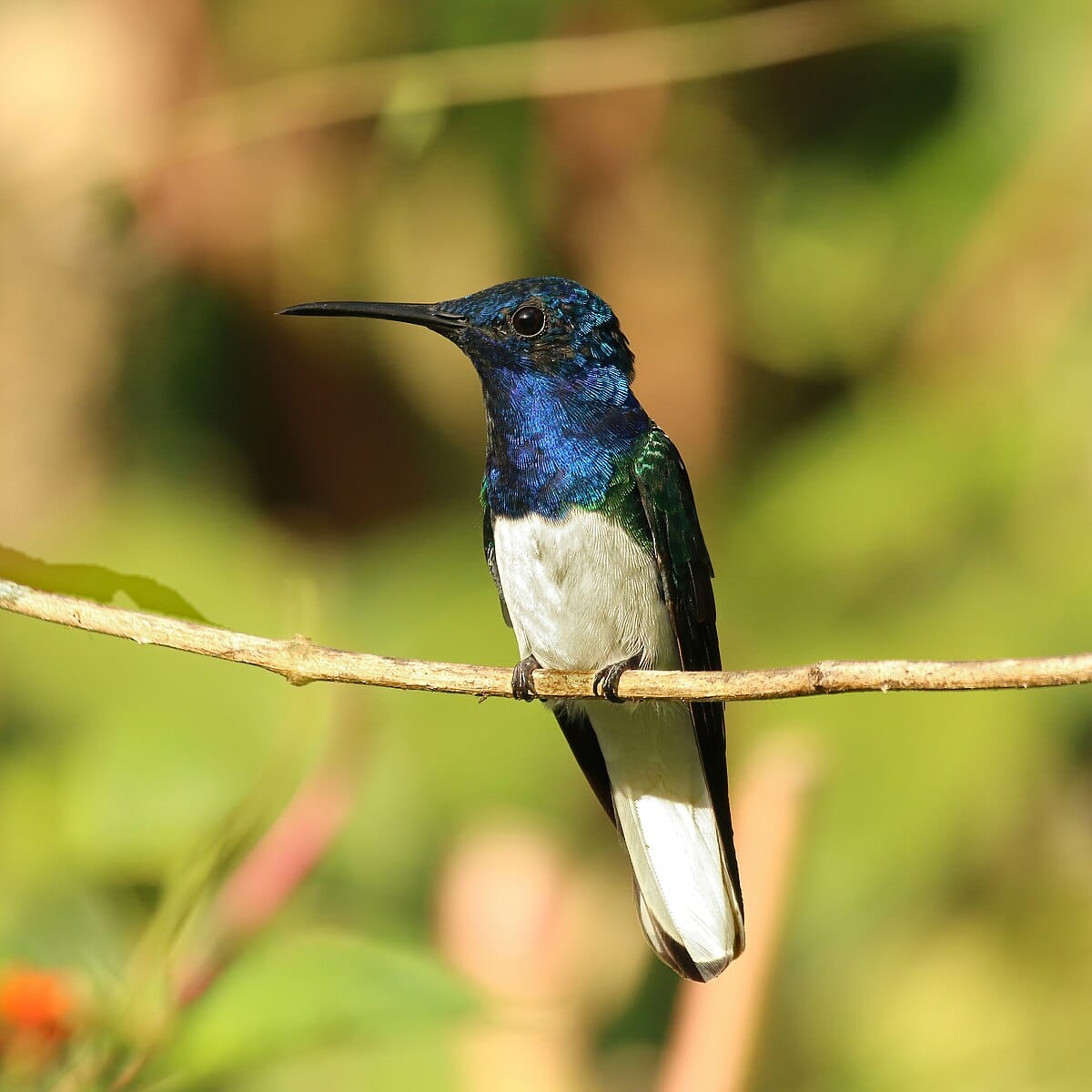
Scientific Name
Florisuga mellivora
Size
Length: 4.3 – 4.7 inches (11 – 12 cm)
Weight: 6 – 8 grams
Wingspan: ~5.9 inches (15 cm)
Range
The White-necked Jacobin is widespread across tropical Central and South America, from southern Mexico through Panama to the Amazon Basin. It is a year-round resident throughout most of its range.
Habitat
It inhabits tropical rainforests, forest edges, plantations, and secondary growth areas, often near streams or rivers. They are commonly seen visiting flowering shrubs and trees in forest clearings.
Diet
Their diet consists primarily of nectar from a wide range of tropical flowers, including heliconias, passionflowers, and bromeliads. They also consume small insects captured during flight.
Nesting
Nests are built on slender branches or hanging vines, often overhanging streams. The nests are composed of soft plant materials, spider silk, and lichens. Females lay two eggs and incubate them for about 15–17 days.
Behavior
White-necked Jacobins are active, energetic fliers known for their aggressive defense of feeding territories. They often engage in aerial chases and display acrobatic maneuvers. Males perform elaborate courtship displays, hovering and flashing their bright plumage.
Conservation
Listed as Least Concern, their populations are stable. Habitat loss due to deforestation is the primary long-term concern, but they adapt well to disturbed forests and plantations.
Identification Tips
Males are striking, with a vivid blue head, bright white collar and belly, and glossy green back. Females are more variable, often speckled with green and white and lacking the bold collar.
Fun Facts
The White-necked Jacobin is a frequent model for tropical bird photography due to its striking coloration and fearless nature.
Males perform an aerial “pendulum display” during courtship, swinging back and forth in front of females.
19. Green-breasted Mango (Anthracothorax prevostii)
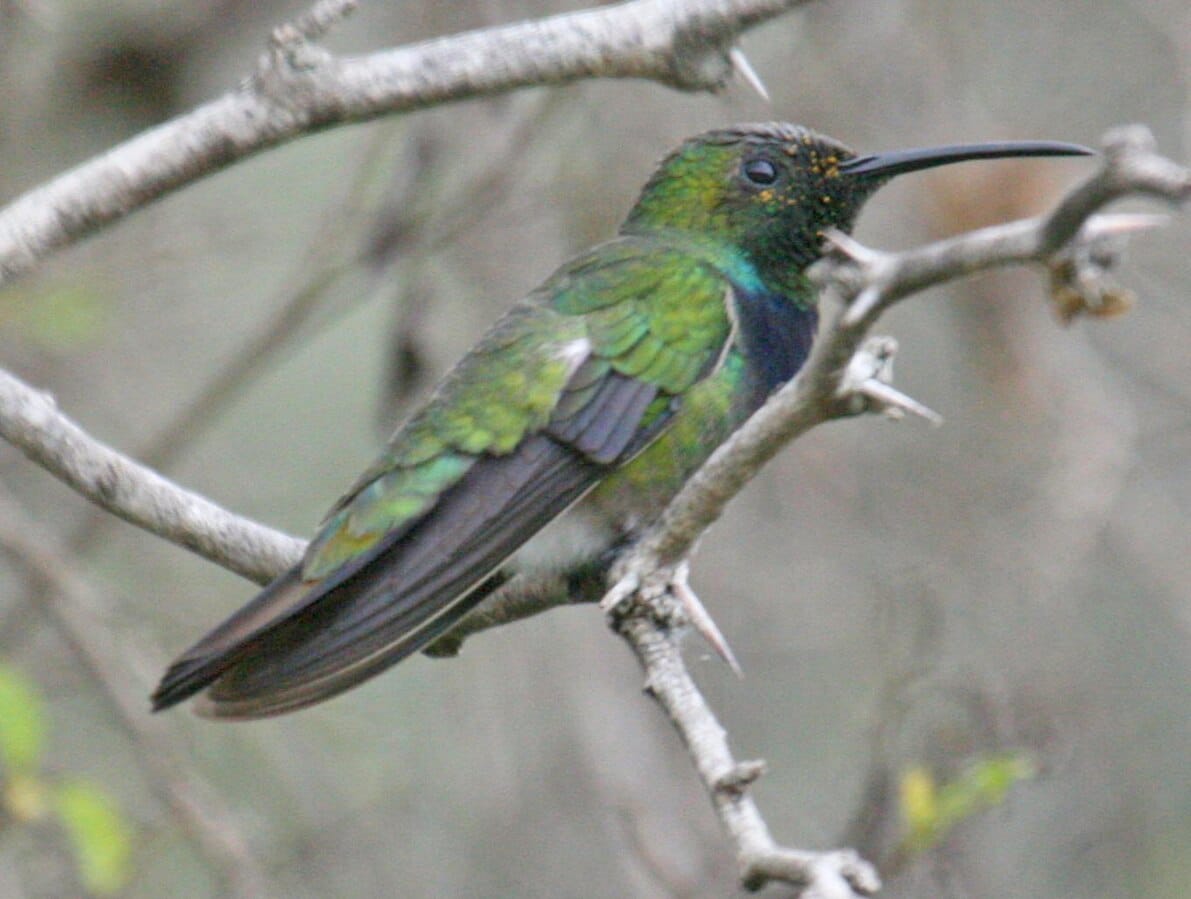
Scientific Name
Anthracothorax prevostii
Size
Length: 4.3 – 4.7 inches (11 – 12 cm)
Weight: 6 – 7 grams
Wingspan: ~5.5 inches (14 cm)
Range
The Green-breasted Mango ranges from eastern Mexico and Central America to northern South America. It occasionally strays into southern Texas during migration.
Habitat
It inhabits tropical forests, mangroves, plantations, and gardens, often near coastal regions. They are particularly abundant in lowland areas with abundant flowering trees.
Diet
Their diet consists mainly of nectar from large tropical flowers such as hibiscus, heliconia, and coral trees. They also catch insects mid-air to supplement their diet with protein.
Nesting
Females build nests high in trees or on exposed branches, often near flowering plants. The nests are built from plant down and spider silk, with lichens for camouflage. The clutch consists of two eggs, incubated for 15–17 days.
Behavior
Green-breasted Mangos are bold and territorial. Males defend flower patches and feeders aggressively, often performing rapid aerial chases. They are powerful fliers and can hover steadily for long periods.
Conservation
Listed as Least Concern, their populations are stable, though habitat loss due to coastal development can reduce local populations.
Identification Tips
Males are unmistakable with a metallic green back and a glossy green breast bordered by blue. Females have a dark central stripe down the chest, bordered by white and green feathers.
Fun Facts
They are one of the few hummingbird species frequently seen in mangrove habitats.
The species name “mango” comes from their bright, tropical plumage reminiscent of the fruit’s colors.
20. Cinnamon Hummingbird (Amazilia rutila)
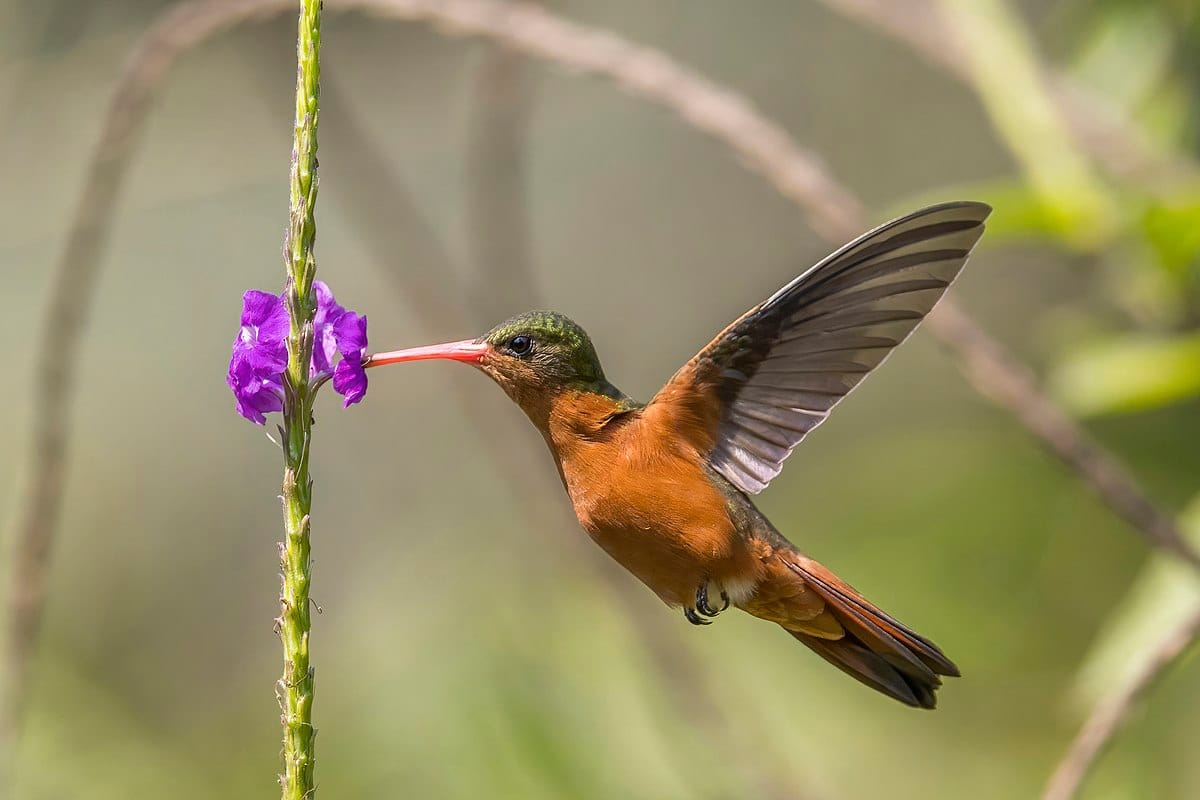
Scientific Name
Amazilia rutila
Size
Length: 3.9 – 4.3 inches (10 – 11 cm)
Weight: 3.5 – 4.2 grams
Wingspan: ~4.7 inches (12 cm)
Range
The Cinnamon Hummingbird is found from western Mexico through Central America, reaching as far south as Costa Rica. It is a common resident species throughout its range.
Habitat
It inhabits dry forests, open woodlands, scrublands, and gardens, often at lower elevations. They are frequent visitors to feeders and urban parks.
Diet
Their diet primarily consists of nectar from flowering shrubs, trees, and vines, including agave and hibiscus. They also consume small insects and spiders, particularly during the breeding season.
Nesting
Females build nests in trees or shrubs, using plant fibers, spider silk, and lichens. Clutches typically contain two eggs, which hatch after about 14–16 days.
Behavior
Cinnamon Hummingbirds are active and aggressive, often defending territories from other birds. They are also known for their rapid, darting flight and persistent vocalizations during feeding.
Conservation
Listed as Least Concern, the Cinnamon Hummingbird’s population is stable. Their adaptability to human-modified landscapes helps ensure their long-term survival.
Identification Tips
This species is easily identified by its warm cinnamon-colored underparts, metallic green back, and reddish bill tipped with black. Both sexes look similar, though females are slightly duller.
Fun Facts
Their bold coloration and aggressive nature make them dominant at feeders.
They often return to the same feeding territories year after year.
21. Plain-Capped Starthroat (Heliomaster constantii)
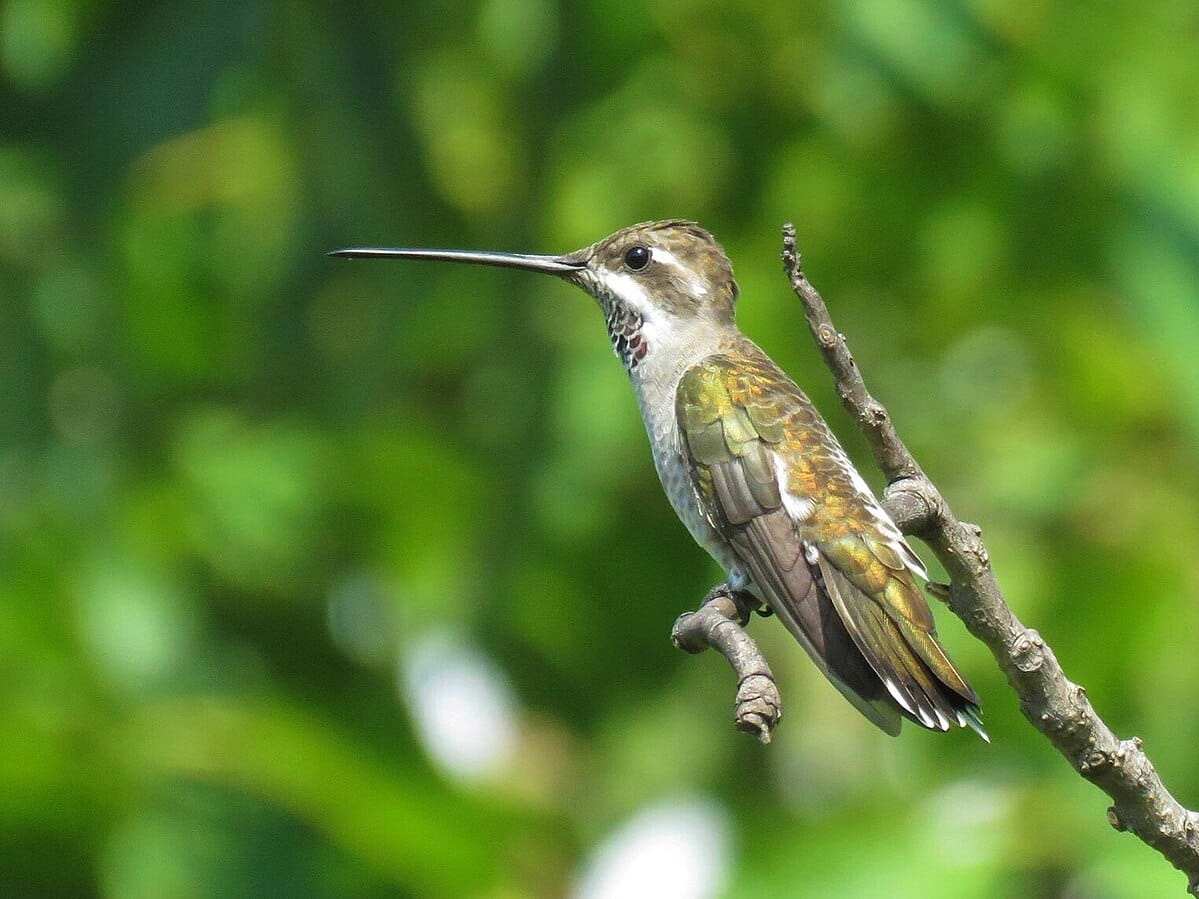
Scientific Name
Heliomaster constantii
Size
Length: 4.3 – 4.7 inches (11 – 12 cm)
Weight: ~7 – 8 grams
Wingspan: ~5 – 6 inches (13 – 15 cm)
Range
The Plain-capped Starthroat is a medium-sized hummingbird native to Mexico, Central America, and the extreme southern United States, especially southeastern Arizona and southwestern New Mexico. It extends southward into Honduras, Nicaragua, Costa Rica, and parts of Panama, thriving in a range of semi-arid habitats and dry forests.
Habitat
This species is often found in oak woodlands, dry forests, desert edges, and scrubby hillsides. It prefers elevations between 1,000 and 7,000 feet (300 – 2,100 m), where flowering plants are abundant. During the breeding season, they may also be seen near streams, canyons, and riparian corridors where nectar sources are rich.
Diet
The Plain-capped Starthroat’s diet consists mainly of:
🌺 Nectar: It feeds from a wide range of tubular flowers, including agaves, ocotillo, salvias, and penstemons.
🐛 Insects: Like most hummingbirds, it supplements its diet with small arthropods such as gnats, aphids, and spiders, often caught mid-air or gleaned from leaves.
This dual diet provides the high energy needed to support their rapid metabolism and long-distance flight.
Nesting
Females build small cup-shaped nests on horizontal tree branches, typically 10–20 feet above ground. The nests are crafted from plant down, lichens, and spider silk, camouflaging them against the bark.
Clutch size: 2 eggs
Incubation: ~15–18 days
Fledging: ~20–23 days after hatching
Males do not participate in nesting or chick-rearing, focusing instead on defending territories rich in floral resources.
Behavior
This species is known for its territorial and solitary behavior. Males fiercely guard feeding territories from rivals and other nectar-feeders. Their flight is strong and direct, with rapid wingbeats and frequent hovering. They are also known for their agile aerial insect-catching skills, which complement their nectar feeding.
During the breeding season, males perform short, darting courtship flights accompanied by soft “tseep” calls. Plain-capped Starthroats are partial migrants, with northern populations moving southward during colder months.
Conservation Status
IUCN Status: Least Concern
Population Trend: Stable
Despite habitat changes due to development and agriculture, this species remains widespread and adaptable. Its ability to use both wild and human-altered habitats has helped it maintain healthy numbers.
Identification Tips
Bill: Long, straight, and slightly decurved — ideal for deep tubular flowers.
Throat: Males show a brilliant magenta or reddish star-shaped gorget against a white underbelly.
Back: Iridescent green with bronze tones.
Tail: Broad and dark with pale tips, slightly forked in males.
Fun Facts
This species’ name “starthroat” comes from its striking star-like throat patch when hit by sunlight.
It is one of the largest hummingbirds seen in the United States.
Plain-capped Starthroats sometimes feed on sap wells made by sapsuckers, drinking the sugary exudate and catching trapped insects.
22. Mexican Violetear (Colibri thalassinus)
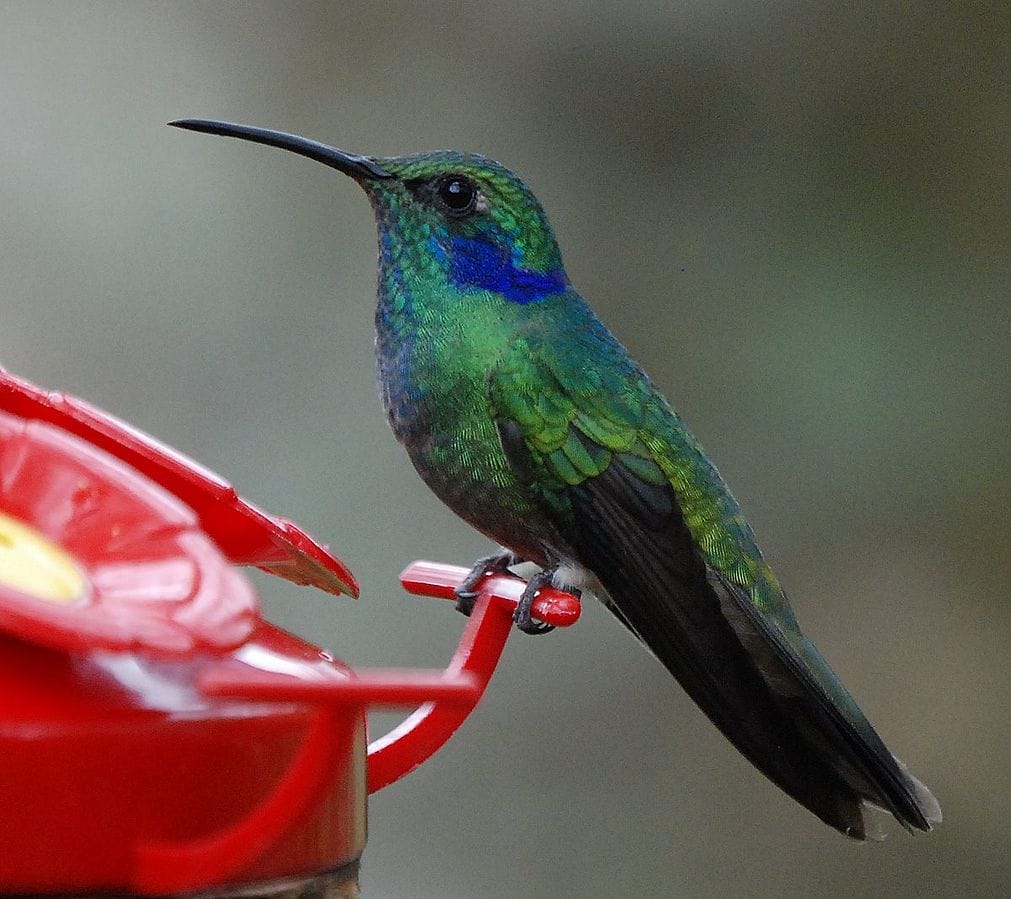
Scientific Name
Colibri thalassinus
Size
Length: 4.3 – 4.7 inches (11 – 12 cm)
Weight: ~5 – 6 grams
Wingspan: ~5.5 inches (14 cm)
Range
The Mexican Violetear is native to highland forests of Mexico and Central America, with a range extending from southern Texas to northern Nicaragua. Occasional vagrants are reported as far north as the United States and Canada during migration or post-breeding dispersal.
Habitat
Prefers humid montane forests, cloud forests, and forest edges at elevations of 3,000 – 10,000 feet (900 – 3,000 m). It is often found near flower-rich clearings and secondary growth, making it a frequent visitor to gardens and forest-edge feeders.
Diet
🌸 Nectar: Specializes in nectar from deep tubular flowers such as Fuchsia, Inga, and Salvia species.
🐜 Insects: Catches small insects mid-air or gleans them from foliage, providing essential proteins for growth and feather development.
Its long, slightly curved bill and extensible tongue are perfectly adapted for reaching deep into blossoms.
Nesting
Females construct small cup-shaped nests lined with plant down and spider silk. They place them on horizontal branches 6–20 feet off the ground, often near flowering shrubs.
Clutch size: 2 white eggs
Incubation: ~14–17 days
Fledging: ~20–23 days post-hatching
The female solely handles incubation and chick-rearing.
Behavior
Mexican Violetears are highly active and territorial, often engaging in mid-air chases around flowering plants or feeders. They are capable of sustained hovering and can fly backward or upside down briefly when defending a feeding spot.
They are altitudinal migrants, moving to lower elevations in winter. During the breeding season, males gather in leks, singing persistent high-pitched calls to attract females — a unique behavior among hummingbirds.
Conservation Status
IUCN Status: Least Concern
Population Trend: Stable
Despite minor habitat loss due to deforestation, this species remains abundant across its range. Its adaptability to gardens and human-planted landscapes has contributed to its success.
Identification Tips
Coloration: Brilliant metallic green body with a vibrant violet ear patch extending from below the eye.
Tail: Slightly notched and metallic blue-green with dark subterminal bands.
Behavior: Frequently perches in visible locations between feeding bouts — a useful ID cue.
Fun Facts
The name “Violetear” refers to the violet-colored ear patch, one of the most distinctive field marks.
It is known for wandering widely — some individuals travel over 1,000 miles north of their breeding range.
Males may defend multiple feeding territories simultaneously, patrolling a circuit throughout the day.
22. Long-billed Starthroat (Heliomaster longirostris)
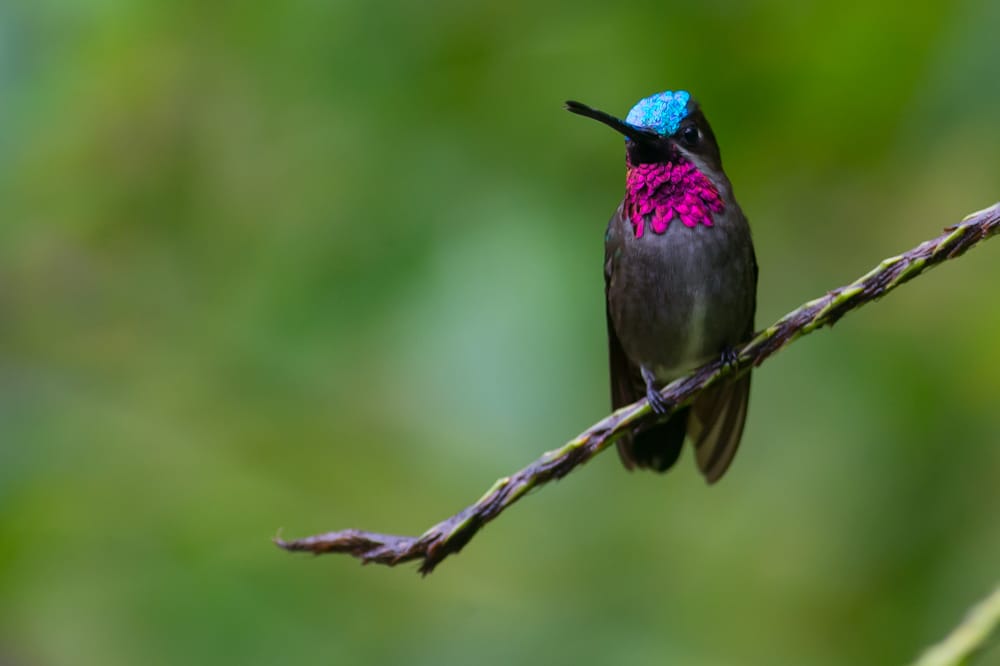
The Long-billed Starthroat is one of the most visually captivating hummingbirds in Central America, instantly recognizable for its elongated bill, iridescent plumage, and striking throat patch that gleams like a jewel in the sun. This species is a member of the Trochilinae subfamily and is known for its impressive agility, adaptability, and unique foraging techniques. Although not as commonly seen as the Ruby-throated or Black-chinned Hummingbirds, the Long-billed Starthroat is highly valued among birdwatchers for its beauty and graceful flight.
Scientific Name
Heliomaster longirostris
Size
Length: 4.7 – 5.1 inches (12 – 13 cm)
Weight: 5 – 6 grams
Range
The Long-billed Starthroat is native to tropical and subtropical regions of Central America and parts of northern South America. Its range stretches from southern Mexico through Belize, Guatemala, Honduras, Nicaragua, and Costa Rica, extending into Colombia, Venezuela, and northern Brazil. In some areas, especially at the northern edge of its range, it is considered a rare but regular visitor.
Habitat
This species thrives in semi-open landscapes, forest edges, tropical lowlands, riverine woodlands, and secondary forests. It is often found near flowering trees and shrubs, especially in areas that offer a combination of open flight space and perching opportunities. While it typically occupies elevations below 3,300 feet (1,000 m), it has been observed at higher elevations during seasonal migrations.
Diet
Like most hummingbirds, the Long-billed Starthroat’s diet is centered around nectar, which it extracts from a wide range of tubular flowers. Its unusually long bill allows it to reach deep into blossoms that are inaccessible to many other hummingbird species, reducing competition for food. Common nectar sources include Heliconia, Inga, and Erythrina species.
In addition to nectar, it supplements its diet with small insects and spiders, which provide essential protein — particularly during breeding season and chick rearing. These are often caught in mid-air or plucked from leaves and webs.
Nesting
The breeding season varies geographically but typically occurs from March to July in Central America. Females construct small, cup-shaped nests out of plant down, spider silk, and lichen, usually placing them on slender tree branches or vines between 6 and 20 feet above the ground.
Each clutch usually contains two white eggs, which the female incubates alone for about 15–17 days. Once hatched, the chicks remain in the nest for another 20–25 days before fledging. During this time, the mother is solely responsible for feeding and protecting them.
Behavior
The Long-billed Starthroat is a solitary and territorial species, often defending its favorite feeding sites from other hummingbirds. It exhibits a distinctive hovering style, often pausing briefly in front of flowers before darting to the next one with rapid wingbeats.
Males are known for their spectacular aerial courtship displays, involving steep climbs, dives, and rapid side-to-side movements to impress potential mates. Their vocalizations are subtle — a soft series of high-pitched “tsee-tsee” notes — and are often used to communicate territory boundaries or courtship intent.
Conservation Status
The Long-billed Starthroat is listed as Least Concern by the IUCN. Its population is stable, and it adapts relatively well to habitat changes as long as flowering plants are available. However, ongoing deforestation and habitat fragmentation in parts of its range could pose localized threats, particularly in areas with heavy agricultural development.
Identification Tips
Bill: Exceptionally long and slender, even for a hummingbird.
Throat: Bright magenta to ruby-red gorget, highly iridescent in sunlight.
Plumage: Greenish upperparts, grayish-white underparts, and a dark tail with white tips.
Flight: Strong, direct flight with frequent hovering pauses near flower clusters.
Fun Facts
The species name longirostris literally means “long-beaked,” referring to its distinctive bill shape.
Because of its specialized feeding technique, the Long-billed Starthroat often pollinates plant species that few other birds can access.
It has been observed performing mid-air “tail flicks” as a part of its territorial defense — a behavior unique among hummingbirds.
23. Azure-crowned Hummingbird (Saucerottia cyanocephala)
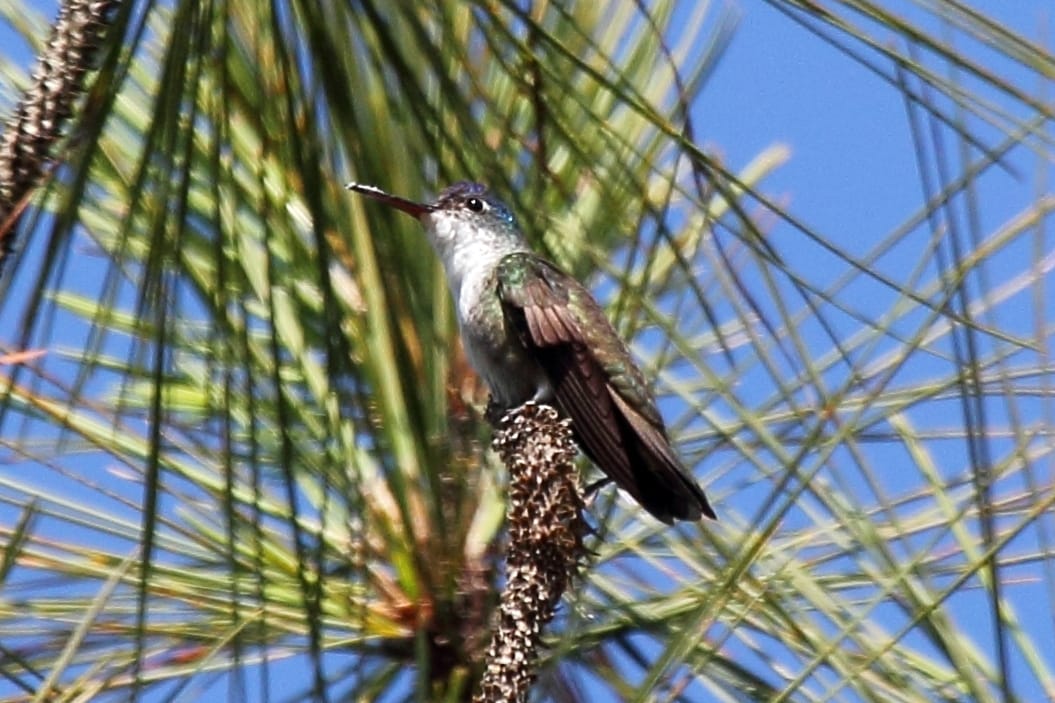
The Azure-crowned Hummingbird is a dazzling mid-sized hummingbird named for the vibrant blue crown that crowns its head. Known for its elegant appearance and calm temperament, this species is a favorite among birders across Mexico and Central America. Although not as widespread as some other hummingbird species, the Azure-crowned is an essential pollinator in its ecosystem and an enchanting sight in any tropical garden or forest edge.
Scientific Name
Saucerottia cyanocephala
Size
Length: 3.9 – 4.3 inches (10 – 11 cm)
Weight: 3.5 – 4.5 grams
Range
The Azure-crowned Hummingbird is distributed from central and southern Mexico through Guatemala, Honduras, El Salvador, and Nicaragua. Its range overlaps with several other hummingbird species, though it is less common in heavily urbanized regions. Populations are often concentrated in highland areas and foothills with abundant flowering plants.
Habitat
This species inhabits montane forests, coffee plantations, scrublands, and forest edges at elevations ranging from 2,600 to 8,200 feet (800 – 2,500 m). It shows a preference for areas with dense understory vegetation and plentiful flowering shrubs, where it can feed and nest with minimal disturbance. During migration or in search of food, it occasionally descends into lower elevations.
Diet
The Azure-crowned Hummingbird’s diet consists primarily of nectar from a wide variety of flowers, including Salvia, Penstemon, and Agave. Its medium-length bill makes it well-suited for feeding from flowers of moderate depth. Like other hummingbirds, it also consumes insects and arthropods, often captured during short, darting flights or plucked directly from foliage.
Nesting
Nesting typically occurs during the rainy season (April to August). The female builds a small, well-camouflaged nest from plant fibers, spider webs, and lichens, usually positioned on a horizontal branch or in a forked twig about 6–12 feet above the ground.
She lays two white eggs, which are incubated for about 15–16 days. After hatching, the chicks are fed a mixture of nectar and insects for about three weeks until they are ready to fledge. Parental care is exclusively provided by the female.
Behavior
This species is slightly less aggressive and territorial than many other hummingbirds, often tolerating the presence of others at shared feeding sites. It is a swift and precise flier, capable of intricate aerial maneuvers to access even the most hidden flowers.
Males perform subtle aerial displays during courtship, including slow hovering arcs and high-speed chases. Its vocalizations are soft and insect-like, consisting of high-pitched “tsee” notes repeated rapidly.
Conservation Status
The Azure-crowned Hummingbird is classified as Least Concern by the IUCN, with stable population numbers. However, its reliance on montane habitats makes it vulnerable to deforestation and habitat degradation, particularly from agricultural expansion and urbanization.
Identification Tips
Crown: Brilliant azure-blue crown and forehead — its most distinctive feature.
Body: Metallic green upperparts and pale grayish underparts.
Tail: Dark, slightly forked tail with a bluish sheen.
Behavior: Less aggressive at feeders, often seen feeding alongside other species.
Fun Facts
Its stunning blue crown feathers are structural rather than pigmented — the color comes from light refraction through microscopic feather structures.
The Azure-crowned Hummingbird plays a crucial role as a pollinator for high-altitude plant species in Central America.
It’s one of the few hummingbirds known to forage in light rain, taking advantage of reduced competition from other species.
24. Andean Hillstar (Oreotrochilus estella)
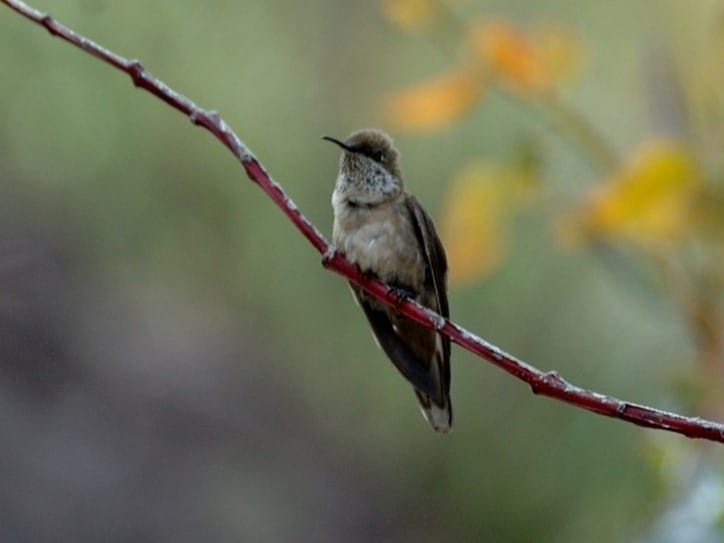
The Andean Hillstar is one of the most remarkable hummingbirds in the world, thriving in some of the harshest environments on Earth. Unlike many hummingbirds that prefer warm, tropical habitats, this species has adapted to the frigid, oxygen-thin highlands of the Andes. It is a true symbol of resilience and evolution, showcasing the incredible diversity of the hummingbird family. Its unique physiology, plumage, and behaviors make it a must-know species for any bird enthusiast or wildlife researcher.
Scientific Name
Oreotrochilus estella
Size
Length: 5.1 – 5.5 inches (13 – 14 cm)
Weight: 8 – 9 grams
Range
The Andean Hillstar inhabits the high-altitude regions of the Andes Mountains across Peru, Bolivia, Chile, and northern Argentina. It is commonly found at elevations between 10,000 and 15,000 feet (3,000 – 4,500 m), where temperatures can drop below freezing even during the day. Its ability to survive and thrive at such altitudes sets it apart from nearly all other hummingbird species.
Habitat
This species prefers puna grasslands, rocky slopes, and areas with scattered shrubs and flowering plants near glaciers and alpine lakes. It often frequents regions dominated by Chuquiraga shrubs, which produce bright orange flowers and serve as one of its main nectar sources. Shelter is typically sought in rock crevices or dense vegetation, which helps it conserve heat during frigid nights.
Diet
The Andean Hillstar feeds mainly on nectar from high-altitude flowers such as Chuquiraga and Siphocampylus, many of which bloom under cold and windy conditions. Because flowers are less abundant in these alpine regions, the hillstar also supplements its diet with insects and spiders. It frequently catches them in mid-air or gleans them from vegetation, ensuring a balanced diet rich in protein.
Nesting
Breeding usually occurs during the austral summer (November to March). The female builds a sturdy nest made of moss, lichen, and animal hair, often tucked into rock crevices or the sides of cliffs to protect it from wind and predators. She lays two white eggs, which she incubates for about 17–20 days. The chicks fledge roughly 30 days after hatching.
Behavior
Unlike most hummingbirds, the Andean Hillstar spends a significant amount of time perched to conserve energy. It uses a combination of hovering and perching while feeding — a necessary adaptation in the oxygen-poor air of the Andes. It is also known for entering a state of torpor at night, lowering its metabolic rate dramatically to survive freezing temperatures.
Conservation Status
Listed as Least Concern, the Andean Hillstar’s population is stable. However, climate change poses a potential threat, as rising temperatures could reduce the range of high-altitude flowering plants it depends on.
Identification Tips
Plumage: Males display a shimmering green back, white underparts, and a striking purple throat. Females are duller with streaked throats.
Behavior: Frequently seen perched on rocks or low shrubs in open alpine landscapes.
Flight: Slower and less erratic than most hummingbirds due to high-altitude adaptations.
Fun Facts
It’s one of the few hummingbirds that cannot tolerate heat; they are rarely seen below 9,800 feet.
The Andean Hillstar is often observed basking in the sun to raise its body temperature after cold nights.
Its metabolic adaptations make it one of the most specialized hummingbirds in existence.
25. Giant Hummingbird (Patagona gigas)
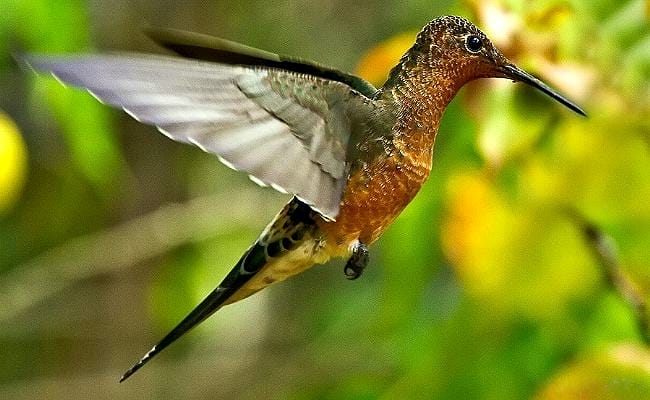
The aptly named Giant Hummingbird holds the record as the largest hummingbird species in the world, stretching the boundaries of what we think of when we imagine these tiny, high-energy birds. Despite its size, this remarkable species maintains many of the same delicate behaviors as its smaller relatives, including hovering flight and rapid wingbeats — though at a noticeably slower pace.
Scientific Name
Patagona gigas
Size
Length: 8.5 – 9.0 inches (21.5 – 23 cm)
Weight: 18 – 24 grams
Range
This species inhabits a wide stretch of the Andes, ranging from Colombia and Ecuador down through Peru, Bolivia, Chile, and Argentina. It is most common at elevations between 6,600 and 11,500 feet (2,000 – 3,500 m), often migrating vertically with the seasons in search of flowering plants.
Habitat
Giant Hummingbirds prefer montane scrublands, arid slopes, valleys, and open woodland habitats where large nectar-producing plants grow. They are frequently associated with Puya bromeliads and Tristerix mistletoes, both of which produce abundant nectar suited to their larger energy needs.
Diet
Nectar is the Giant Hummingbird’s primary food source, and its long, straight bill allows it to access deep flowers that smaller hummingbirds cannot reach. Its massive size means it needs to consume significantly more nectar daily — sometimes visiting up to 1,500 flowers per day. It also supplements its diet with insects and spiders, which provide vital protein for muscle maintenance and reproduction.
Nesting
Nests are constructed from plant fibers, moss, and spider silk, usually placed on horizontal branches or rock ledges. Females lay two eggs, which are proportionally larger than those of most hummingbirds. The incubation period lasts about 20 days, and fledging occurs roughly a month later.
Behavior
Due to its size, the Giant Hummingbird has a slower wingbeat — about 10–15 beats per second compared to 50+ in smaller species. It hovers gracefully and spends more time perching to conserve energy. It is territorial but less aggressive, often engaging in slow, deliberate chases rather than high-speed aerial battles.
Conservation Status
Currently listed as Least Concern, the Giant Hummingbird’s population is stable. Habitat degradation and climate shifts remain potential long-term concerns, particularly in regions where flowering plant diversity is declining.
Identification Tips
Size: Nearly twice the length and weight of most hummingbirds.
Plumage: Plain brownish or grayish tones with a rufous tail. Males and females look similar.
Flight: Noticeably slower and more deliberate, resembling a large moth in motion.
Fun Facts
Its wingspan can exceed 8.5 inches, the largest among all hummingbirds.
Despite being much larger, its heart rate can still exceed 600 beats per minute in flight.
Some indigenous Andean cultures consider it a symbol of endurance and spiritual strength.
26. Sword-billed Hummingbird (Ensifera ensifera)
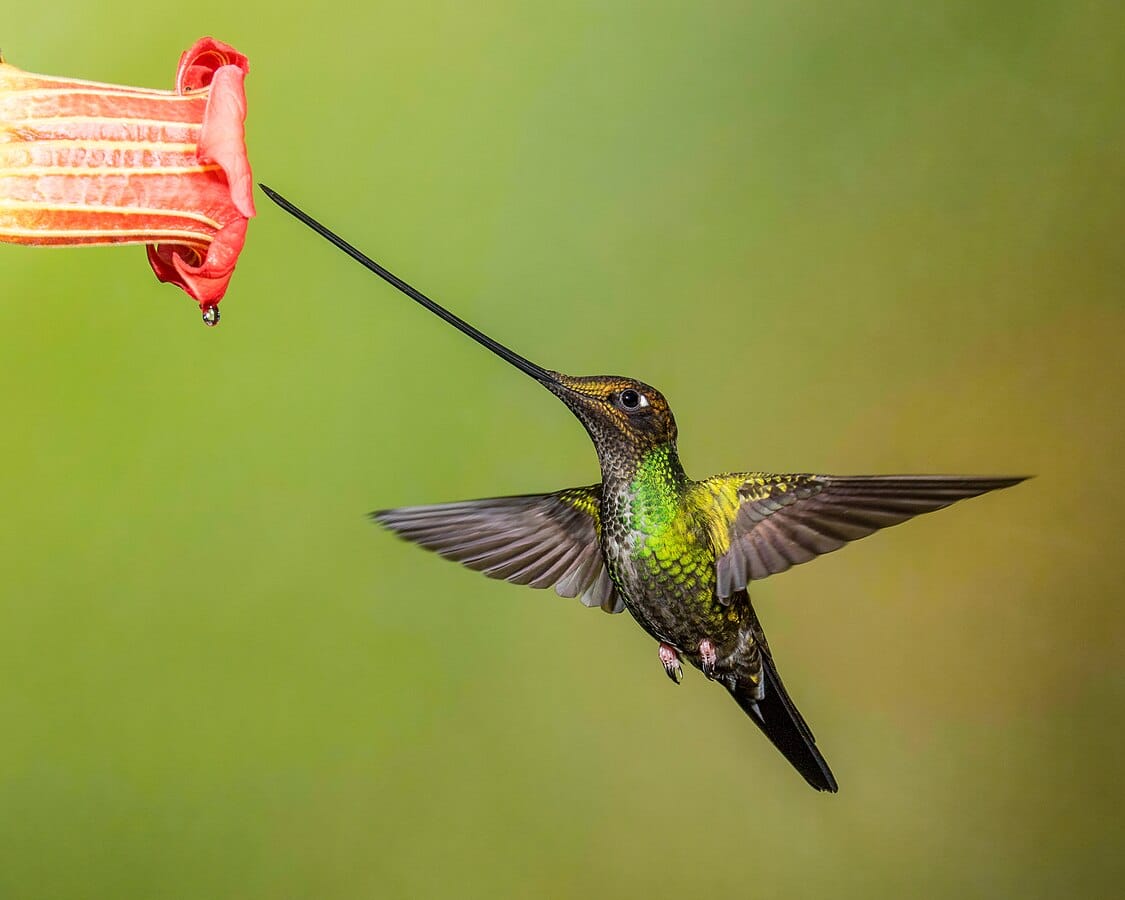
Few birds capture the imagination quite like the Sword-billed Hummingbird. With a bill longer than its entire body, this extraordinary species has evolved one of the most extreme anatomical adaptations in the avian world. Its unique beak allows it to feed on flowers that are inaccessible to nearly every other hummingbird, giving it a specialized ecological niche.
Scientific Name
Ensifera ensifera
Size
Length: 7.9 – 9.8 inches (20 – 25 cm)
Weight: 10 – 15 grams
Bill Length: Up to 4.7 inches (12 cm), often longer than the body itself
Range
This species is found along the Andes from Venezuela and Colombia to Bolivia, typically at elevations of 6,500 to 10,500 feet (2,000 – 3,200 m). It is a resident of cloud forests, montane woodlands, and high-altitude valleys.
Habitat
The Sword-billed Hummingbird prefers humid montane forests, often in areas rich in passionflowers (Passiflora), which have long corollas that match the bird’s extraordinary bill length. It is commonly seen near forest edges and flowering clearings, where it hovers with remarkable precision despite the weight of its elongated beak.
Diet
Nectar is its primary food source, and its bill is perfectly adapted to deep-tubed flowers that other hummingbirds cannot exploit. This specialization reduces competition and makes it a crucial pollinator for certain plant species. It also eats insects, capturing them in mid-air or gleaning them from foliage, particularly during breeding season.
Nesting
Females construct cup-shaped nests out of plant fibers and spider silk, usually attaching them to mossy branches overhanging streams or forest paths. They lay two eggs, which hatch after about 18–20 days. Fledglings leave the nest about 28–32 days later.
Behavior
Because of its long bill, the Sword-billed Hummingbird grooms its feathers and preens with its feet — a behavior rarely seen in other hummingbirds. It is territorial and fiercely defends its feeding grounds. Despite its unusual proportions, it remains agile and capable of intricate aerial maneuvers.
Conservation Status
Currently classified as Least Concern, though localized habitat loss from deforestation can threaten populations in some regions. Its dependence on specific flower species makes it particularly vulnerable to ecosystem changes.
Identification Tips
Bill: Exceptionally long and straight — unmistakable among hummingbirds.
Plumage: Iridescent green back, bronze underparts, and a slightly forked tail.
Behavior: Often perches upright with its bill pointing downward to balance its weight.
Fun Facts
The Sword-billed Hummingbird is the only bird in the world with a bill longer than its body (excluding tail feathers).
Its bill allows it to coevolve with long-tubed flowers, forming a unique ecological partnership.
Observing one feed is a spectacular sight — it often hovers motionless while delicately inserting its “sword” into a flower.
27. Violet-tailed Sylph (Aglaiocercus coelestis)
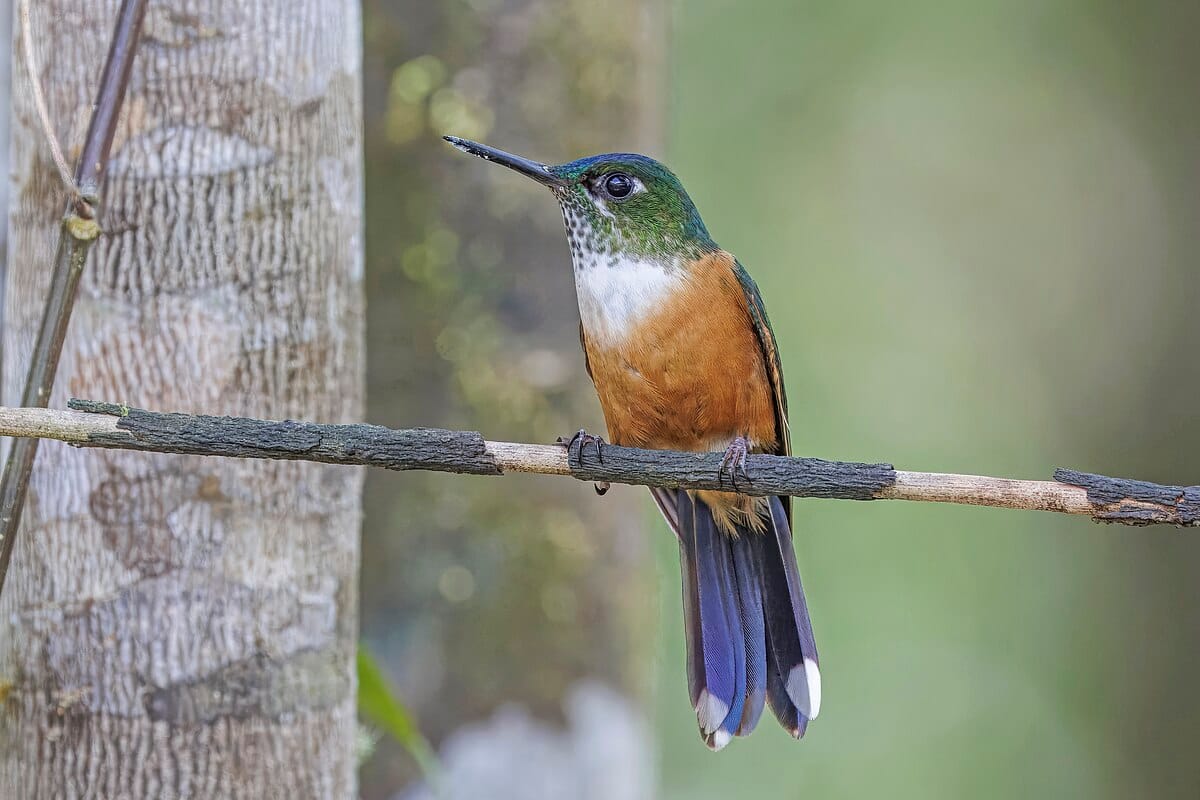
If any hummingbird can be described as magical, it’s the Violet-tailed Sylph. With its dazzling metallic plumage and spectacularly long, iridescent tail streamers, this species is one of the most breathtaking birds in the world. Native to the cloud forests of northwestern South America, the sylph is a favorite target for photographers and birdwatchers alike. Its graceful flight, striking colors, and specialized ecological role make it one of the crown jewels of hummingbird diversity.
Scientific Name
Aglaiocercus coelestis
Size
Length: 5.5 – 7.1 inches (14 – 18 cm) (males, including tail)
Weight: 4 – 5 grams
Range
The Violet-tailed Sylph is native to the Andean cloud forests of Colombia and Ecuador, primarily inhabiting the western slopes of the Andes. Its range is relatively limited compared to other hummingbirds, which makes sightings especially prized by birders.
Habitat
This species thrives in humid montane cloud forests between 3,300 and 8,200 feet (1,000 – 2,500 m). It prefers areas with abundant epiphytes and flowering shrubs, often near forest edges, ravines, or along streams. Because it is sensitive to habitat changes, it is most commonly seen in protected reserves and undisturbed habitats.
Diet
The Violet-tailed Sylph feeds on nectar from a wide range of tubular flowers, including Fuchsia, Bomarea, and Passiflora. Its long, decurved bill allows it to reach deep into blossoms. In addition to nectar, it consumes small arthropods, often caught on the wing or collected from leaves and webs.
Nesting
Breeding occurs primarily from March to June. Females build small, cup-shaped nests from moss, plant fibers, and spider silk, typically hidden in dense vegetation or attached to thin branches overhanging streams. They lay two eggs and incubate them for about 16–18 days. Fledging occurs roughly 20–24 days after hatching.
Behavior
The Violet-tailed Sylph is known for its graceful and acrobatic flight, often hovering in place for extended periods while feeding. Males frequently display their elongated tail feathers during territorial or courtship displays, fanning and twisting them to catch the light. Territorial disputes can involve impressive mid-air chases and vocal confrontations.
Unlike some aggressive hummingbirds, sylphs are relatively tolerant of other species, especially at shared feeding sites, though males still defend prime flower patches during peak bloom.
Conservation Status
The Violet-tailed Sylph is currently listed as Least Concern, but its population is believed to be slowly declining due to deforestation and habitat fragmentation. Conservation efforts focusing on cloud forest protection are vital to ensuring its long-term survival.
Identification Tips
Tail: Extremely long, iridescent violet-blue streamers in males (shorter, less vivid in females).
Plumage: Shimmering green body, turquoise crown, and a glittering blue-violet tail.
Flight: Slow, deliberate, and graceful, often hovering motionless for several seconds.
Fun Facts
Males’ tail feathers can exceed twice the length of their bodies, used primarily in courtship displays.
The sylph’s plumage appears to change color based on light angle due to structural iridescence.
It is one of the most sought-after species by birdwatchers visiting the Andean cloud forests.
28. Booted Racket-tail (Ocreatus underwoodii)
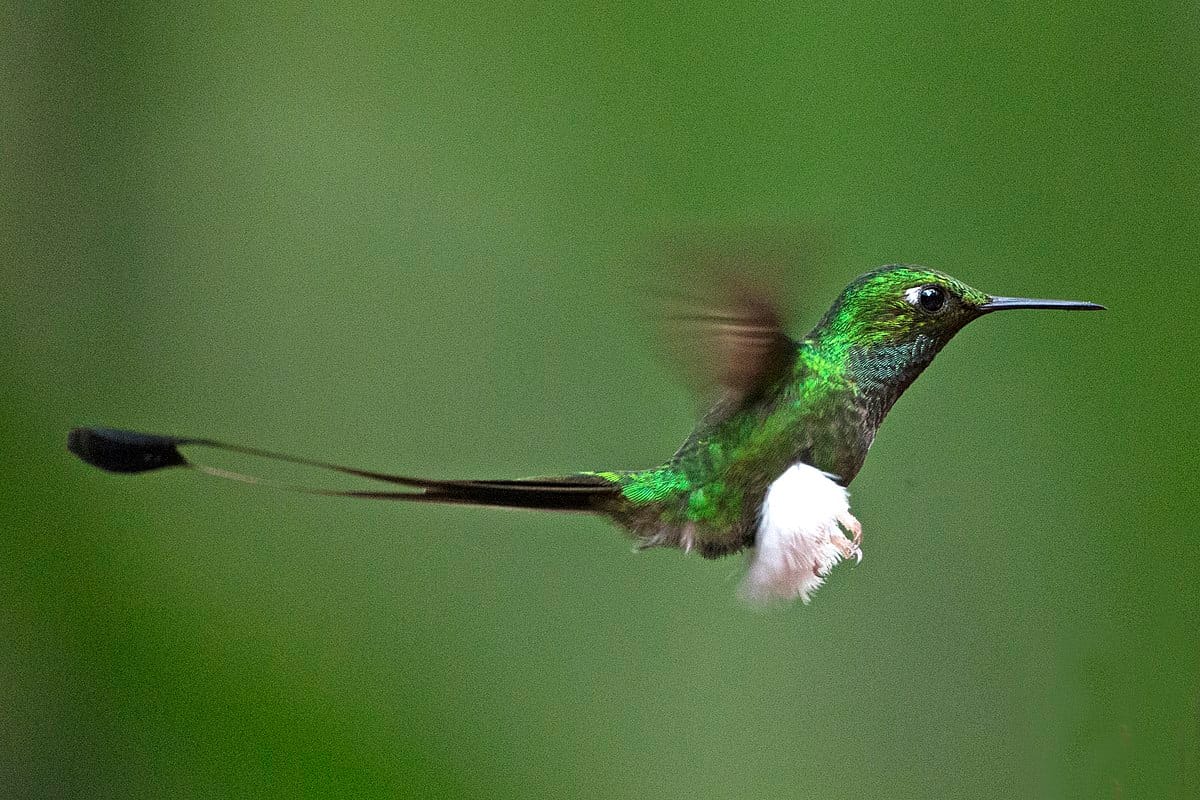
The Booted Racket-tail is one of the most unique and visually striking hummingbirds in the Andes. Its name derives from two key features: the “boots,” which are feathered legs that resemble tiny slippers, and the “rackets,” long tail feathers with flattened tips that resemble tennis rackets. This species is a master of aerial acrobatics, and its specialized morphology makes it a favorite among ornithologists and bird photographers.
Scientific Name
Ocreatus underwoodii
Size
Length: 3.5 – 4.3 inches (9 – 11 cm) (excluding tail streamers)
Weight: 3 – 4 grams
Tail Streamers: Males’ tail can extend an additional 2–3 inches
Range
Booted Racket-tails are native to the eastern slopes of the Andes in South America, from Venezuela and Colombia down through Ecuador, Peru, and Bolivia. They inhabit mid-elevation cloud forests, typically between 3,300 and 7,900 feet (1,000 – 2,400 m).
Habitat
This species prefers humid montane cloud forests, forest edges, and secondary growth. They are often found near flowering shrubs and vines, especially those with deep tubular flowers, and are highly adaptable to areas with mixed vegetation. They are seldom seen in open lowlands, preferring the cover and floral abundance of cloud forests.
Diet
Booted Racket-tails feed primarily on nectar from tubular flowers such as Fuchsia, Bomarea, and Inga. Their small size and long tail allow them to maneuver easily among dense foliage. Like other hummingbirds, they also eat small insects and spiders for protein, particularly during breeding season and chick rearing.
Nesting
Females construct tiny cup-shaped nests from plant down, spider silk, and moss, often attached to slender branches 6–15 feet above the ground. Breeding usually occurs during the wet season when flowers are abundant. Two eggs are laid per clutch, incubated for approximately 15–16 days, and fledging occurs 20–22 days after hatching.
Behavior
Males perform elaborate displays to attract females, including hovering with tail streamers spread wide and rapid aerial maneuvers. They are territorial but relatively tolerant of other species at shared feeding areas. Their “booted” legs, though small, help them cling to flowers and thin branches while feeding or resting.
Conservation Status
The IUCN lists the Booted Racket-tail as Least Concern. Populations are stable, though habitat loss from deforestation in parts of the Andes could impact local populations over time.
Identification Tips
Tail: Males have long “racket” tail feathers with flattened tips, highly distinctive in flight.
Legs: Feathered “boots” covering the lower legs.
Plumage: Iridescent green upperparts, white underparts, and bright green throat.
Fun Facts
Tail streamers are used exclusively for courtship and territorial displays.
The species’ name underwoodii honors British collector Henry Underwood.
They can hover in extremely dense vegetation thanks to their small size and agile wings.
29. Buff-tailed Coronet (Boissonneaua flavescens)
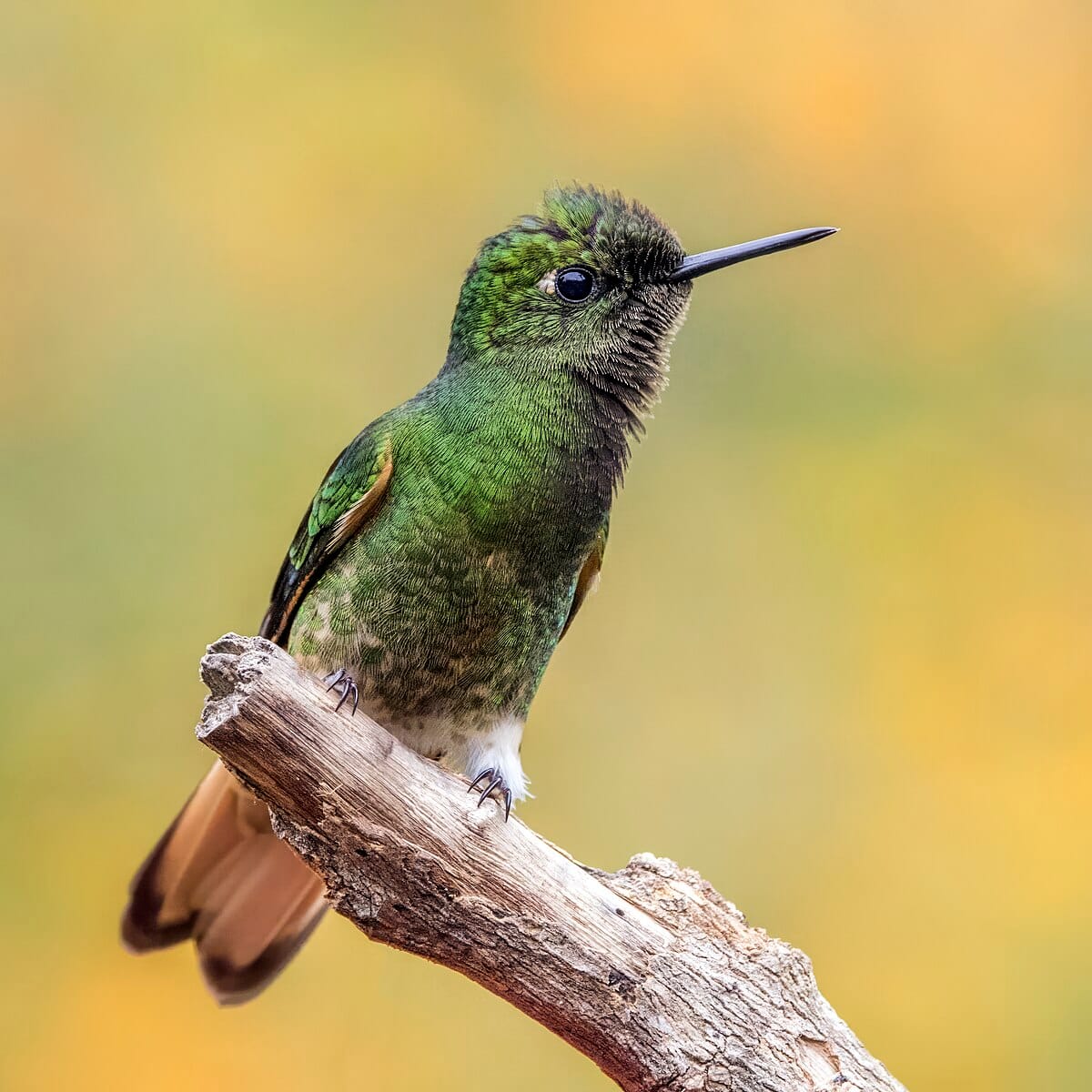
The Buff-tailed Coronet is a robust hummingbird with vibrant plumage and a buff-colored tail that gives it its name. Native to the Andean cloud forests, this species is a key pollinator and exhibits remarkable adaptability in feeding and territorial behaviors.
Scientific Name
Boissonneaua flavescens
Size
Length: 5.1 – 5.5 inches (13 – 14 cm)
Weight: 6.5 – 7.5 grams
Range
This species inhabits humid montane forests along the Andes from Venezuela to northern Peru, generally at elevations of 5,900 to 9,800 feet (1,800 – 3,000 m). It is most commonly found on forest edges, ridges, and clearings where flowers are abundant.
Habitat
Buff-tailed Coronets prefer dense cloud forests, secondary growth, and flowering ridges, often near streams or humid valleys. They are adaptable to human-altered landscapes with suitable floral resources but are primarily associated with intact montane ecosystems.
Diet
Like most hummingbirds, the Buff-tailed Coronet feeds mainly on nectar, favoring tubular flowers such as Fuchsia, Inga, and Passiflora. It also consumes insects and spiders to supplement its diet. Its robust body allows it to dominate certain flower patches and outcompete smaller hummingbirds.
Nesting
Nesting involves a well-camouflaged cup-shaped nest made from moss, plant fibers, and spider silk. Nests are usually positioned on horizontal branches 6–12 feet above ground. Females lay two eggs per clutch, incubating them for 15–17 days. Fledging occurs approximately 22–25 days post-hatching.
Behavior
Males defend feeding territories vigorously, performing repeated aerial displays to deter rivals. Despite their aggressive nature, Buff-tailed Coronets often share flowering plants with other hummingbird species during peak bloom. They exhibit precise hovering techniques to extract nectar efficiently.
Conservation Status
The IUCN classifies the Buff-tailed Coronet as Least Concern. Its populations are stable, though deforestation in parts of the Andes could pose long-term risks.
Identification Tips
Tail: Buff-colored, giving the species its common name.
Plumage: Iridescent green back, dark wings, and a white throat with green flecks.
Behavior: Strong territorial displays with repetitive hovering near flowers.
Fun Facts
Their large size allows them to dominate feeders and flowers over smaller hummingbirds.
The species’ name flavescens refers to the yellowish tint of its tail.
Buff-tailed Coronets are excellent pollinators for cloud forest plants due to their long, precise feeding bouts.
30. Blue-tufted Starthroat (Heliomaster furcifer)
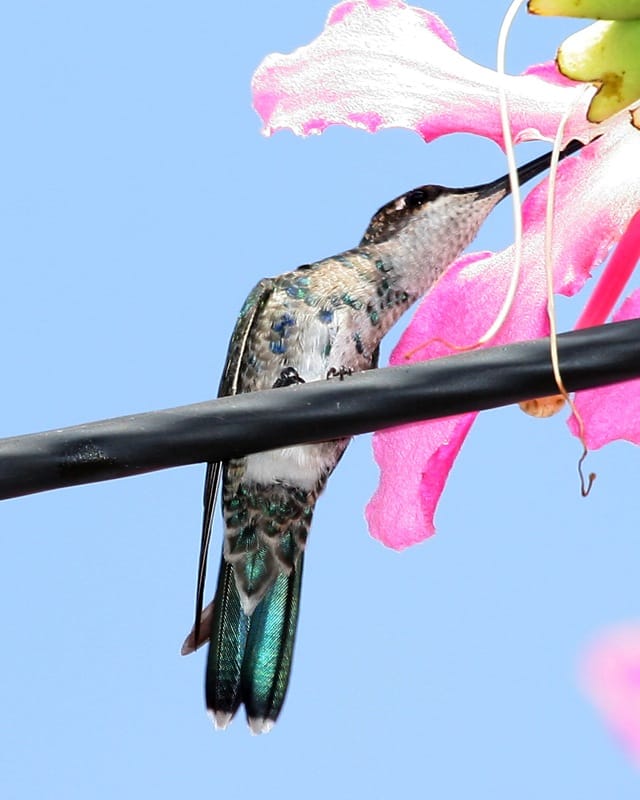
The Blue-tufted Starthroat is a medium-sized hummingbird renowned for the brilliant blue tufts on its throat and head, which shimmer dramatically in sunlight. Its combination of dazzling coloration, swift flight, and bold behavior makes it a favorite among bird enthusiasts in South America.
Scientific Name
Heliomaster furcifer
Size
Length: 4.7 – 5.1 inches (12 – 13 cm)
Weight: 5 – 6 grams
Range
This species inhabits tropical and subtropical forests from Venezuela to northern Brazil, primarily in lowland and foothill regions up to 3,300 feet (1,000 m) in elevation. It favors areas with abundant flowering plants and scattered trees.
Habitat
Blue-tufted Starthroats are typically found in forest edges, secondary growth, gardens, and scrublands, often near streams or clearings where sunlight promotes flowering. They prefer areas with a mix of open spaces for flight and dense vegetation for shelter.
Diet
Their diet consists primarily of nectar from tubular flowers, including Heliconia, Inga, and Bignonia. Small insects and spiders supplement their diet, especially for protein during breeding. The species’ long, slightly curved bill allows access to deeper flowers that are inaccessible to smaller hummingbirds.
Nesting
Nesting occurs during peak flower availability. Females build a delicate cup-shaped nest of plant down, moss, and spider silk on thin branches or vines. Clutches of two eggs are incubated for 15–16 days, with fledging occurring 20–22 days later.
Behavior
Males are territorial and perform hovering displays to defend feeding territories. Courtship involves rapid ascents and short dives while spreading the iridescent blue throat tufts to attract females. They are agile in flight and often share flowering trees with other hummingbird species without conflict.
Conservation Status
The Blue-tufted Starthroat is Least Concern, with a stable population. Habitat degradation and deforestation may impact local populations, but overall adaptability helps maintain numbers across its range.
Identification Tips
Throat: Striking blue tufts that flare dramatically in sunlight.
Plumage: Metallic green upperparts, grayish-white underparts, and a forked tail.
Behavior: Bold, agile, and often seen defending nectar-rich trees.
Fun Facts
Its throat tufts are used exclusively for courtship, creating flashes of iridescent color in flight.
The species is highly territorial, often chasing off intruders larger than itself.
Blue-tufted Starthroats are critical pollinators for many lowland tropical flowers due to their precise feeding patterns.
31. Black-tailed Trainbearer (Lesbia victoriae)
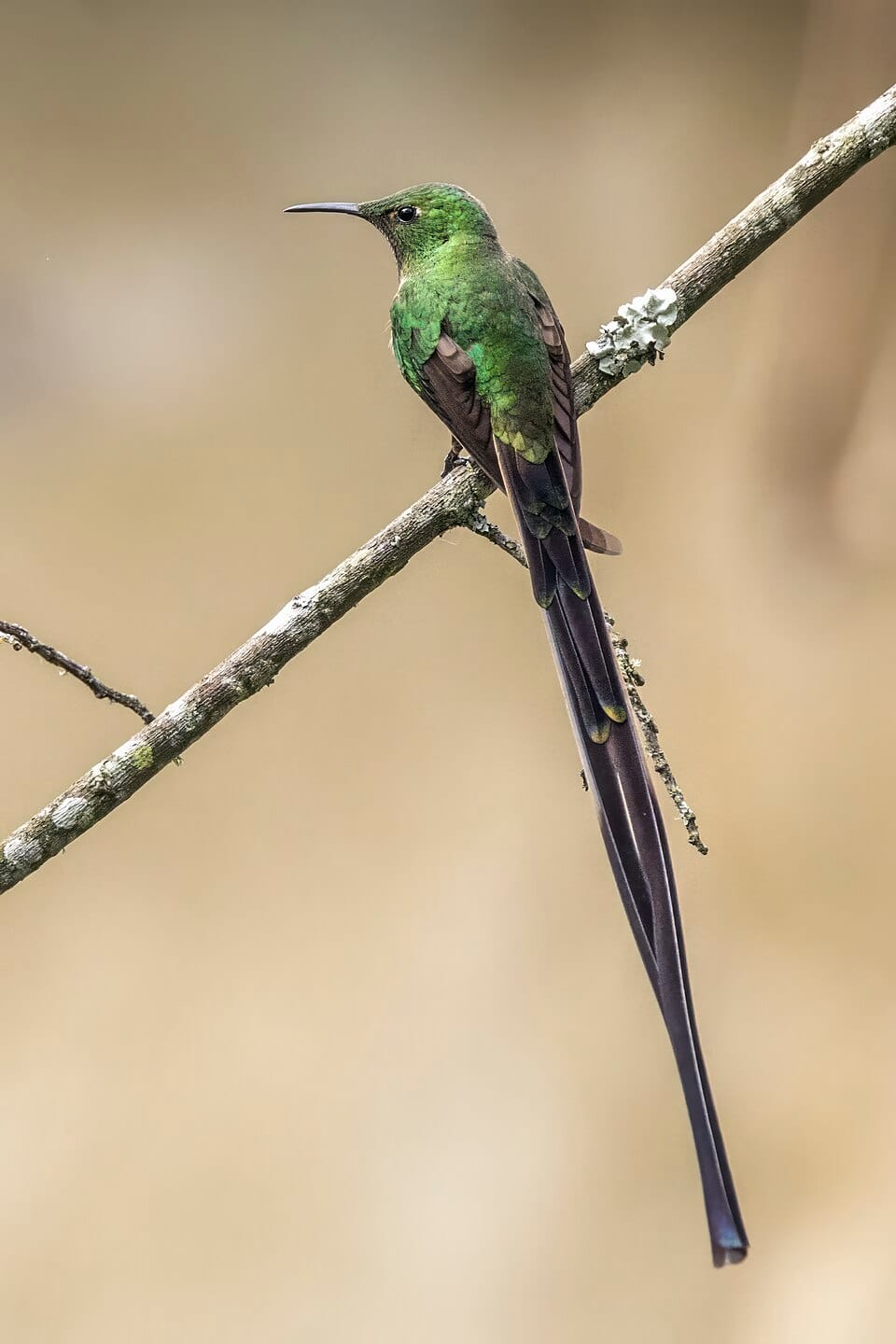
The Black-tailed Trainbearer is a long-tailed hummingbird native to the Andean highlands, easily recognized by its extraordinarily long tail feathers, which resemble a train trailing behind the bird in flight. These feathers, particularly prominent in males, are not only striking visually but play a crucial role in courtship displays and territorial interactions.
Scientific Name
Lesbia victoriae
Size
Length: 6.7 – 7.9 inches (17 – 20 cm) (including tail)
Weight: 5.5 – 6.5 grams
Range
This species inhabits the Andes from Venezuela through Colombia, Ecuador, Peru, and northern Bolivia, generally at elevations between 6,500 and 11,500 feet (2,000 – 3,500 m). It is especially common in open highland habitats where shrubs and scattered trees provide feeding and nesting opportunities.
Habitat
The Black-tailed Trainbearer prefers high-altitude grasslands, scrublands, and forest edges, often near streams or rocky outcrops. It adapts well to secondary growth and areas with scattered flowering plants, but is rarely found in dense forests or lowlands.
Diet
Its diet is primarily nectar from tubular flowers, including Puya, Fuchsia, and Inga species. Its exceptionally long tail allows the bird to hover and maneuver precisely while feeding, often in windy conditions common at high elevations. Like most hummingbirds, it also consumes insects and spiders for protein.
Nesting
Females construct cup-shaped nests using moss, plant fibers, and spider silk, typically attached to low branches or shrubs. Breeding usually coincides with peak flowering periods. Two eggs are laid per clutch, incubated for 15–17 days, and fledging occurs about 22–25 days post-hatching.
Behavior
Males perform spectacular aerial displays to attract females, often flying in steep arcs while fanning their long tail feathers to create vivid flashes of iridescence. They are territorial and defend prime nectar sources, frequently engaging in mid-air chases with rivals. Despite their bold displays, these birds can also perch quietly for long periods while feeding or resting.
Conservation Status
The IUCN lists the Black-tailed Trainbearer as Least Concern, with stable populations. Their adaptability to human-altered habitats and secondary growth helps buffer against habitat loss in certain regions.
Identification Tips
Tail: Long, black train-like feathers in males; shorter and less prominent in females.
Plumage: Metallic green back, whitish underparts, and a bronze-tinged crown.
Behavior: Aggressive territorial defense, often performing aerial displays near feeders or flowers.
Fun Facts
Its tail can exceed half the bird’s total body length, creating a dramatic visual effect in flight.
The species is named victoriae in honor of Queen Victoria.
Tail feathers are used primarily for courtship and are not functional for flight stability.
32. Amethyst Woodstar (Calliphlox amethystina)
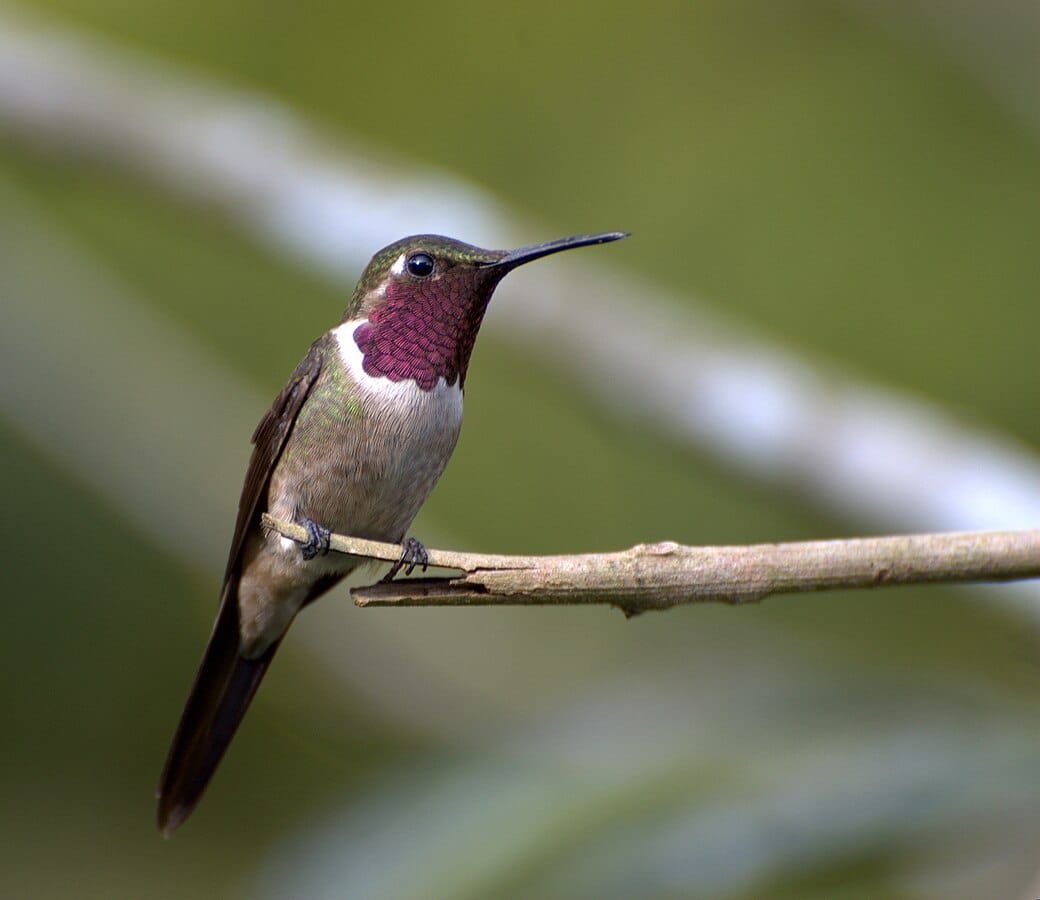
The Amethyst Woodstar is a diminutive yet dazzling hummingbird, famed for its brilliant amethyst-colored throat and crown. Small in size but vibrant in appearance, this species is a master of agility and a frequent visitor to flowering gardens in tropical South America. Its combination of beauty, energy, and ecological importance makes it a highlight of any hummingbird guide.
Scientific Name
Calliphlox amethystina
Size
Length: 3.1 – 3.5 inches (8 – 9 cm)
Weight: 2.5 – 3 grams
Range
This species ranges across tropical forests and lowland regions of Colombia, Venezuela, Ecuador, Peru, Brazil, and the Guianas. It is commonly found at sea level to 3,300 feet (1,000 m), though it occasionally ascends into foothills during seasonal movements.
Habitat
Amethyst Woodstars inhabit tropical and subtropical forests, forest edges, gardens, and plantations, preferring areas with abundant flowering plants. They are particularly fond of flowering shrubs, lianas, and epiphytes that provide nectar throughout the year.
Diet
Their diet consists primarily of nectar from tubular flowers, including Heliconia, Costus, and Hamelia. Due to their small size, they are highly maneuverable and can access flowers that larger hummingbirds cannot. They also eat small insects and spiders to meet protein requirements.
Nesting
Breeding usually coincides with peak flower abundance. Females build tiny cup-shaped nests of plant fibers, moss, and spider silk, often on horizontal branches about 5–10 feet above the ground. Clutches of two eggs are incubated for 14–16 days, and fledging occurs 18–20 days after hatching.
Behavior
Amethyst Woodstars are agile, energetic, and often seen darting rapidly between flowers. Males perform courtship displays that involve hovering with their amethyst throat feathers fully visible, attracting females with flashes of iridescence. Though small, they can be surprisingly territorial around prime nectar sources.
Conservation Status
The IUCN lists the Amethyst Woodstar as Least Concern. Populations are stable, benefiting from their adaptability to gardens and secondary forests. However, ongoing deforestation in parts of the Amazon could impact local populations.
Identification Tips
Throat: Brilliant amethyst-colored throat and crown in males; females are duller with a grayish throat.
Plumage: Metallic green upperparts, white underparts, and a slightly forked tail.
Behavior: Extremely fast and agile, frequently hovering for extended periods while feeding.
Fun Facts
The species is one of the smallest hummingbirds in South America.
Its brilliant throat coloration is due to iridescent feather structures, not pigments.
Despite its tiny size, it plays a vital role as a pollinator for multiple tropical flowering plants.
FAQ’s
1. What is the most common hummingbird?
The Ruby-throated Hummingbird is the most common hummingbird in North America. It is easily recognized by its bright red throat in males and small size, usually about 3 inches long. These hummingbirds migrate long distances, often crossing the Gulf of Mexico during fall and spring. They are found from eastern Canada down to the Gulf Coast in the United States. Their abundance and adaptability make them the most frequently seen hummingbird by bird watchers.
2. What is the most beautiful type of hummingbird?
Many people consider the Violet-crowned Hummingbird or the Anna’s Hummingbird as some of the most beautiful species. Their feathers shimmer with metallic colors, reflecting light in vibrant shades of green, red, purple, or blue. Beauty in hummingbirds often comes from iridescence, which changes color depending on the angle of sunlight. Each species has unique patterns and colors, making them a favorite for photographers and bird lovers. Even tiny differences in feather coloring can make a hummingbird stunning.
3. Why don’t you see baby hummingbirds?
Baby hummingbirds, called chicks, are rarely seen because they stay hidden in small, well-camouflaged nests. Mother hummingbirds build tiny cup-shaped nests using plant fibers, moss, and spider webs, often placed high on branches. The chicks are tiny, weighing less than a penny, and are completely dependent on their mother for warmth and feeding. They usually stay in the nest for 18–22 days before fledging. Their small size and hidden nests make them very difficult to spot in the wild.
4. Which country has the most species of hummingbirds?
Colombia is the country with the highest diversity of hummingbirds, hosting over 160 species. The varied landscapes, from mountains to tropical forests, provide ideal habitats for different species. Ecuador, Peru, and Venezuela also have high numbers of hummingbird species. South America in general is the center of hummingbird diversity. Birdwatchers travel to these countries specifically to see rare and colorful hummingbirds.
5. What’s the most aggressive hummingbird?
The Rufous Hummingbird is known for its aggressive behavior, especially males defending their feeding territories. They chase away larger hummingbirds and even insects that come near their flowers or feeders. Their boldness helps them secure food, which is critical for their high metabolism. Despite their small size, they are fearless and will confront intruders repeatedly. This behavior is most noticeable during the breeding season when food sources are vital for survival.
6. Why is it called Lucifer’s hummingbird?
Lucifer Hummingbird gets its name from the bird’s dark, devilish-looking plumage and aggressive behavior. It is one of the fastest hummingbirds, capable of hovering and darting rapidly while defending its territory. The name reflects its fiery temperament rather than any literal connection to the devil. This species is native to arid regions in Mexico and the southwestern United States. Bird enthusiasts are fascinated by its dramatic flight patterns and vibrant throat colors.
7. What does it mean when a hummingbird keeps visiting you?
If a hummingbird repeatedly visits you, it may be attracted to bright colors, flowers, or feeders you have nearby. In some cultures, it is also seen as a sign of love, good luck, or positive energy. Hummingbirds are curious creatures and may investigate humans out of curiosity. Regular visits indicate that they see your area as a reliable source of food. Observing them can be a joyful and peaceful experience for bird lovers.
8. How rare is a blue hummingbird?
Blue-colored hummingbirds, like the Blue-throated Mountain Gem or the Violet-crowned species, are relatively rare compared to the common Ruby-throated or Anna’s Hummingbirds. The rarity depends on their specific habitats, which are often limited to certain regions of Central or South America. Their stunning blue iridescence makes them highly sought after by birdwatchers. Spotting one in the wild can be a once-in-a-lifetime experience for many enthusiasts. Protecting their habitats is essential to maintain these rare species.
9. What is the top 1 cutest bird in the world?
Many consider the Ruby-throated Hummingbird the cutest bird due to its tiny size, fast wing beats, and brilliant throat colors. Its delicate, jewel-like appearance and playful hovering flight make it captivating to watch. Baby hummingbirds, when visible in nests, are also incredibly adorable with their tiny, featherless bodies. Other contenders for “cutest bird” include the Bee Hummingbird and the tiny Kinglet. Ultimately, cuteness is subjective, but hummingbirds are often top-ranked for charm and beauty.
10. What is a hummingbird’s biggest enemy?
Hummingbirds face threats from predators such as larger birds, snakes, and praying mantises. Domestic cats are also a significant danger, especially near feeders or gardens. Even insects like robber flies can harm young hummingbirds. Their high-energy lifestyle and small size make vigilance crucial for survival. Despite these threats, hummingbirds are agile and quick, which helps them escape many potential predators.
11. What does it mean when a hummingbird hovers in front of your face?
If a hummingbird hovers near your face, it may be showing curiosity or investigating a potential food source. Hummingbirds are naturally curious and use their exceptional vision to examine their surroundings. Some cultures also view this behavior as a spiritual message or good omen. Usually, they quickly move on after investigating. Hovering is a normal part of their flight behavior, allowing precise control and energy-efficient feeding.
12. What scares hummingbirds away?
Hummingbirds can be scared by sudden movements, loud noises, or predators like cats and hawks. Bright reflective surfaces or shiny objects may also deter them temporarily. Using scare devices near gardens can help protect them from hazards. However, they are generally bold and will return once they feel safe. Maintaining a quiet, safe feeding area encourages them to visit regularly.
13. What does the Bible say about hummingbirds?
The Bible does not specifically mention hummingbirds, as they are native to the Americas and the Bible was written before their discovery. However, hummingbirds are often admired in modern Christian writings and symbolism for their diligence, beauty, and joy. Some interpret their tiny size and tireless activity as lessons in faith and perseverance. While not biblical, they are celebrated in nature-based devotionals and spiritual reflections. Observing them can inspire gratitude and mindfulness in everyday life.
14. Where is the best place in the world to see hummingbirds?
South and Central America are the best regions to see the most species of hummingbirds. Countries like Colombia, Ecuador, and Peru host the highest diversity, including rare and colorful species. Specific habitats such as cloud forests and mountainous regions provide food sources and nesting sites. Many birdwatchers travel to these areas to photograph and observe multiple species in one trip. Gardens with feeders in North America also attract common species like the Ruby-throated Hummingbird.
15. How many calories do hummingbirds eat a day?
Hummingbirds consume roughly 100–150 calories per day, which is extremely high relative to their tiny size. Their rapid wing beats and constant flight burn calories quickly. They feed frequently on nectar from flowers and small insects for protein. Some species visit feeders every 10–15 minutes to maintain their energy. Their high metabolism is why they are always seen hovering or moving between flowers.
16. What is the prettiest hummingbird in the world?
Many consider the Violet-crowned Hummingbird or Anna’s Hummingbird among the prettiest, thanks to their bright, iridescent feathers. The tiny Bee Hummingbird, the smallest bird in the world, is also admired for its delicate appearance. Iridescence, unique color patterns, and fast movements make these birds visually stunning. Preferences vary depending on which colors or behaviors viewers find most captivating. Bird photographers and enthusiasts often travel long distances just to see these species.
17. Which bird gets angry easily?
Among hummingbirds, the Rufous Hummingbird is notorious for its aggressive temperament. Males aggressively defend their feeding territories against larger hummingbirds, insects, and even humans who get too close. They dive, chase, and vocalize loudly to ward off intruders. Their aggressive nature ensures access to nectar sources critical for survival. While small, their boldness is impressive and often surprises observers.
18. Why do hummingbirds dive bombs?
Hummingbirds dive-bomb as a defensive or territorial behavior. Males chase away rivals or intruders from feeding areas and mating territories. The sudden, rapid dives can intimidate other birds or insects. Dive-bombing is also part of mating displays in some species, showing off agility and strength. This behavior is natural and helps maintain access to food and potential mates.
19. What is the leading cause of death of hummingbirds?
Predation is the leading cause of death for hummingbirds, with threats including larger birds, snakes, and domestic cats. Collisions with windows and human structures also contribute significantly. Harsh weather, starvation, and loss of habitat can be fatal as well. Despite their agility, their small size makes them vulnerable. Ensuring safe habitats and providing feeders can help hummingbirds survive longer.
20. Why do hummingbirds fight with each other so much?
Hummingbirds fight primarily to defend food sources and territories. Nectar is their main energy source, so competition can be intense. Males are more aggressive during breeding season, often chasing other males or even females temporarily. Fighting includes aerial chases, dive-bombing, and loud vocalizations. While it may seem extreme, these behaviors help maintain survival and reproductive success.
21. What’s the lifespan of a ruby-throated hummingbird?
Ruby-throated Hummingbirds typically live 3 to 5 years in the wild, although some individuals can reach 9 to 10 years. Lifespan depends on predation, food availability, and environmental conditions. Their small size and high metabolism make survival challenging, especially during migration. Proper habitat and food sources increase their chances of living longer. Birdwatchers sometimes band hummingbirds to track their age and migration patterns.
22. Where do hummingbirds spend most of their time?
Hummingbirds spend most of their time foraging for nectar and insects. They visit hundreds of flowers each day to meet their energy needs. Males also patrol territories to protect feeding areas, and females often spend time building and maintaining nests. During migration, they spend extended periods flying long distances between feeding grounds. Resting and preening are less frequent but essential for maintaining their feathers and energy.
23. Which country is known as the hummingbird?
Colombia is often called the “country of hummingbirds” because it has the highest number of hummingbird species in the world, with over 160 species. Its diverse landscapes, from mountains to tropical forests, create ideal habitats. Ecuador and Peru are also rich in hummingbird diversity. The abundance of colorful and rare species makes these countries top destinations for birdwatchers. Hummingbirds are celebrated in local culture and symbolism throughout South America.
24. What is the most territorial hummingbird?
The Rufous Hummingbird is widely recognized as the most territorial species. Males aggressively defend their feeding areas, chasing away other hummingbirds, insects, and even animals that come too close. This bold behavior ensures they have enough nectar to fuel their high metabolism. Territory defense is especially important during breeding season when energy demands are higher. Despite their small size, their fearlessness and rapid dives make them fierce competitors.
25. What is a hummingbird’s biggest enemy?
Hummingbirds face many natural predators, with domestic cats, larger birds, snakes, and even praying mantises posing significant threats. Their tiny size and high-energy lifestyle make them vulnerable to attacks. Collisions with windows, vehicles, and human-made structures are also common dangers. Despite these risks, hummingbirds rely on agility, speed, and quick reflexes to escape predators. Providing safe habitats and keeping cats indoors can help protect these delicate birds.
Conclusion
Hummingbirds are among the most captivating and diverse bird species on the planet, with over 300 known species exhibiting incredible adaptations, colors, and behaviors. From the high-altitude Andean Hillstar to the tiny but dazzling Amethyst Woodstar, each hummingbird has evolved unique strategies to survive and thrive in its environment. Whether it’s the elongated tail of the Black-tailed Trainbearer, the sword-like bill of the Sword-billed Hummingbird, or the brilliant iridescence of the White-necked Jacobin, these birds exemplify nature’s creativity and resilience.
Understanding the types of hummingbirds is not only fascinating for wildlife enthusiasts but also crucial for conservation. Many species rely on specific flowers and habitats, making them vulnerable to deforestation and climate change. By appreciating their diversity and ecological roles, we can better support efforts to protect these remarkable birds and the ecosystems they inhabit.
If you’re eager to observe hummingbirds in the wild, consider visiting gardens, forest edges, or highland regions with abundant flowering plants. Installing feeders with nectar can also attract a variety of species, giving you a front-row seat to their mesmerizing flight patterns and vivid colors.
Hummingbirds are more than just beautiful creatures — they are essential pollinators and vital components of the ecosystems they inhabit. By learning about them, we not only enrich our understanding of nature but also contribute to the preservation of some of the most extraordinary birds on Earth.
Read more:
